
The Brownstone – timber grid, part 1
While I love the ice cream parlor colors of the kit photo, it’s not really my style. I also love Tudor design, but I’m not sure I’ll ever get around to making an authentic Tudor build. There’s a beautiful house by my office that has more modern ranch lines but it is done in Tudor finishes. With the grid and inserts of the Golden Gate View kit, I think it would lend itself well to Tudor inspiration.
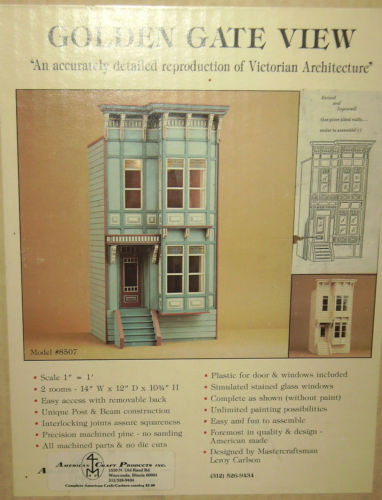
Mike was gracious to lend me his drawing so I could try out some colors. The program is Sketchup, and it is so new to me that I did part of my color mockup in Sketchup and part in PhotoShop.
After searching for stained glass windows online, I found this beautiful Meyda Tiffany Bed of Roses stained glass panel at Wayfair. I altered the image in PhotoShop with the new windows and changed the front door to dark plum. :D
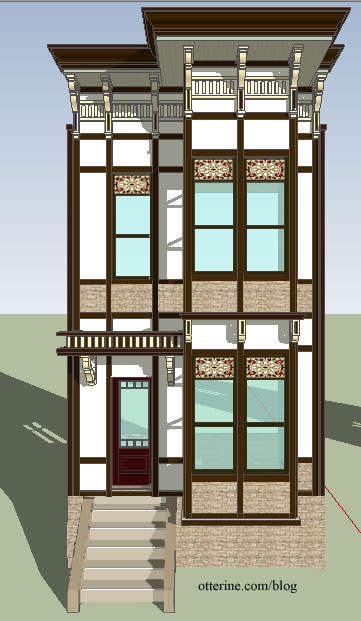
The kit comes with pre-cut notched pieces to make the facade trim work. These measure 5/16″ deep x 11/32″ wide.
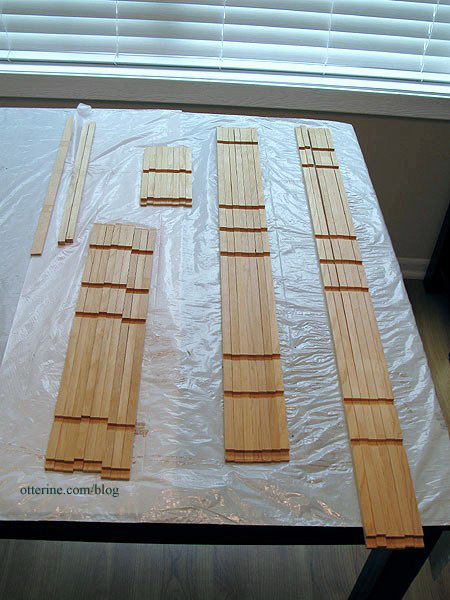
I am now making the facade wider and taller than the original kit intended, which means the kit pieces needed to be reconfigured. Since I won’t be altering the bay window portion, I assembled those walls with glue. Even though the instructions don’t indicate to do this, I used the filler pieces as spacers as I glued the grid together. Some of these filler pieces won’t be used in the end, but they helped keep the grids uniform while the glue dried. The cuts aren’t very precise, with the ends being a little long. Once the grids were glued, I trimmed and sanded the excess.
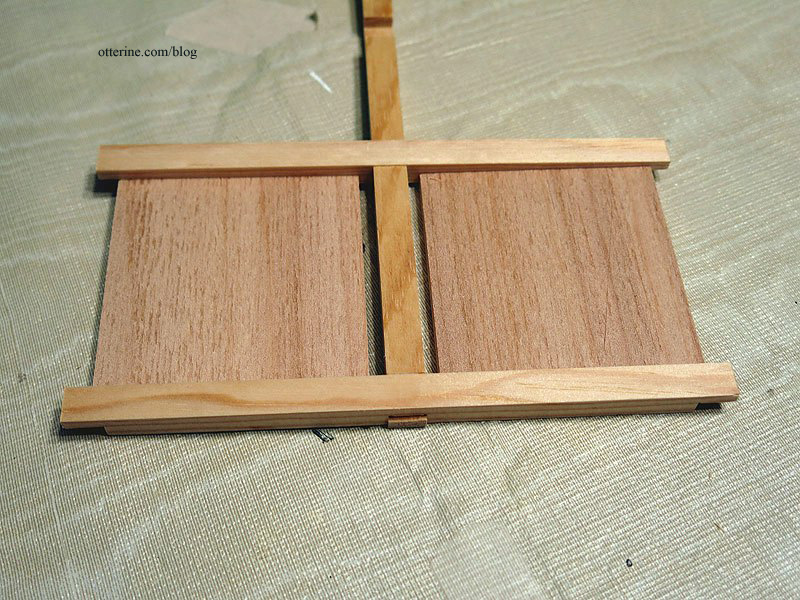
I will leave the bay window assemblies flat for now instead of glued into their final shape. Instead, I taped them together, back into dry fit.
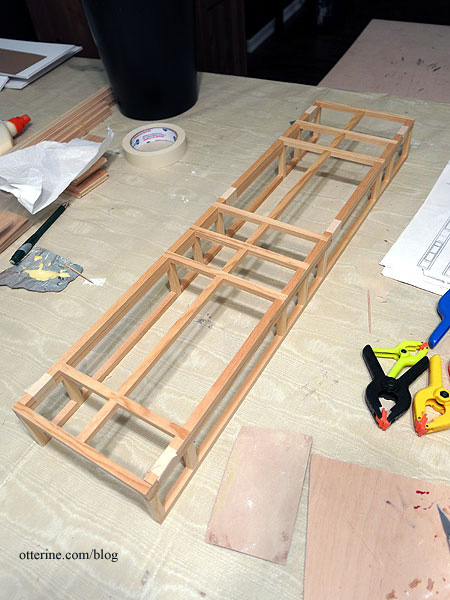
Because the grid isn’t made from square trim, the fit is off when the walls of the bay window are taped together. This will actually work in my favor since I plan to line the interior walls of the bay. You can also see the notches. There is trim to cover these later in the build, but I’ll do something different. More on that later.
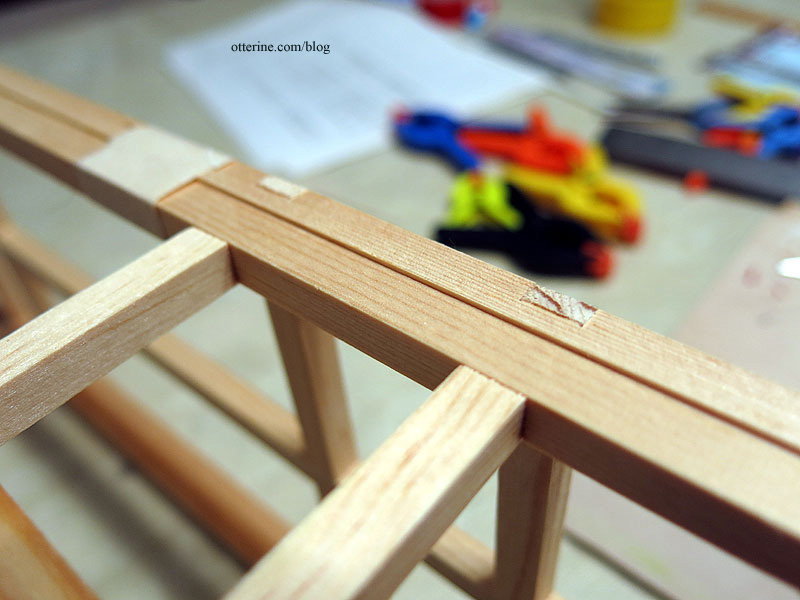
Using my foam core board as a guide, I marked where the bay window would hit along the cross beams on the left side. I marked which trim pieces would be eliminated from the final layout: namely the area below the second to last cross beam. This will be all egg carton stone.
I will also eliminate the trim from the front door area, except the outline. Since I’ll be making a working door frame using the original door, the opening will need to be wider than the notched trim allows. I will fake the trim in this area with strip wood when I get to that point.
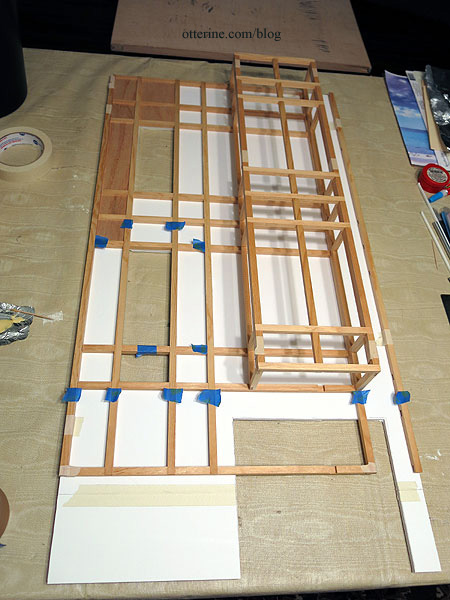
I cut away the vertical and horizontal pieces around the doorway. I also removed the portion below the bay window line.
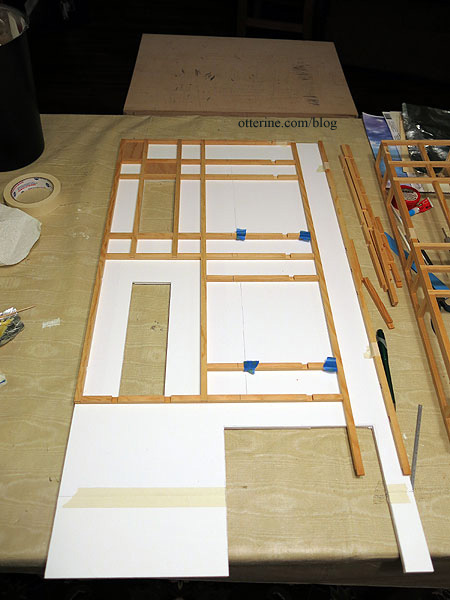
I used some of the cut trim to make a new piece for below the doorway since the original piece had notches.
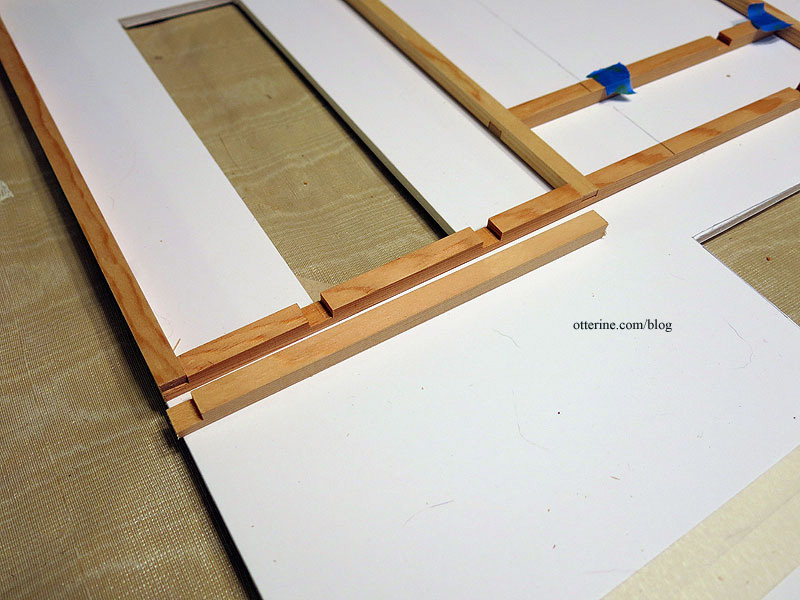
I cut the horizontal pieces up to the left side of where the bay window assembly will sit. The top two horizontal pieces remain in place uncut since that is above the upper floor ceiling line and they will be enclosed by the roof trim. The bottom one is removed since I’ll cut a floor board with the bay window extension included instead of piecing it together.
Instead of using one of the kit’s vertical pieces to sit under the left side of the bay window assembly, I cut a new piece from 5/16″ strip wood. Since there will be a wood back board, this strip doesn’t need to be notched to fit. It will be glued to the backer board and the adjacent horizontal trim ends. I used one of the original verticals for the far right timber and cut another 5/16″ timber for the right side of the bay window.
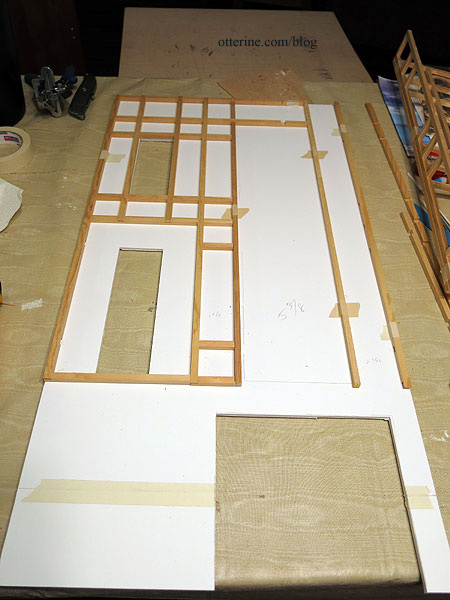
That left cutting short horizontals for the section to the right of the bay window.
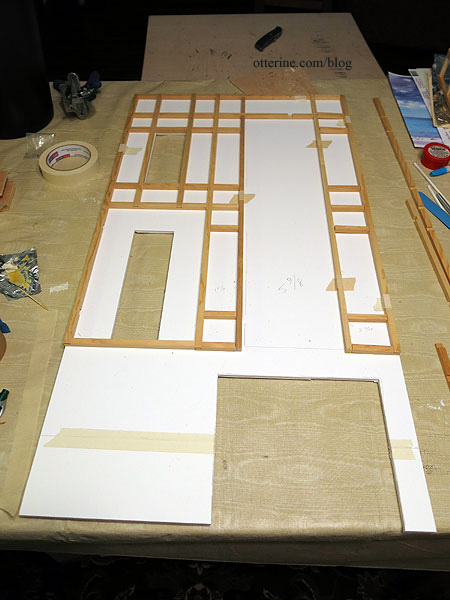
I had plenty of kit timbers to work with, and my Proxxon scroll saw made cutting a snap!
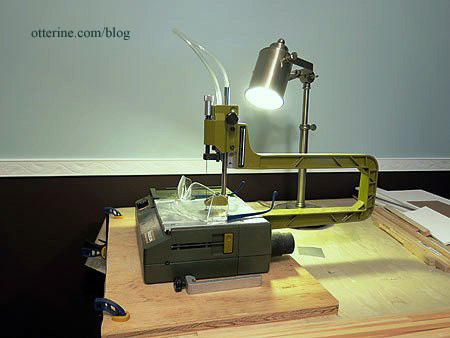
Here’s the final layout for the facade.
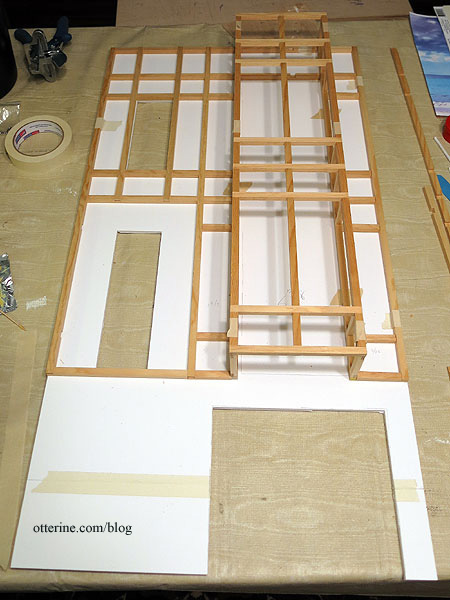
When I get to the sides of the building and the addition, I’ll have to use all 5/16″ basswood since that is what’s available in the stores. It will be close enough to the original to blend, and it will be consistent on those particular walls. I had originally thought about doing the sides in all stone, but I thought the addition should match the facade. With the front and one side done in Tudor style, I might as well carry it around to the other side, too.
Categories: The Brownstone
February 8, 2014 | 0 commentsThe Brownstone – entrance and front steps, part 6
Continuing work on the entrance and front steps. My stones are 1″ x 1/2″ for ease of measuring. This time, I did not clip the four corners, as I normally do for bricks. But, an extra step I did need to do was make sure my stones were square. Made the cutting go a little slower.
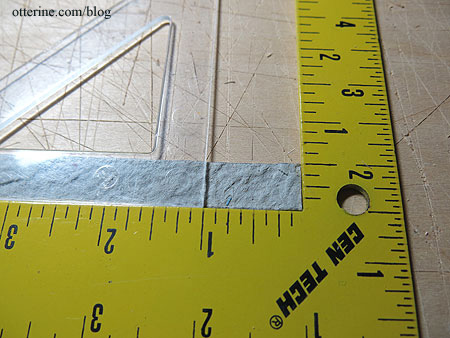
The arch needed to be addressed first, so cut longer 1/2″ wide pieces to wrap around the foam core base. I folded one end to make a 1″ stone. I held that in place and folded the long end around the foam core board base. I marked 1″ on the other side, cut off the excess and glued it in place. I used Weldbond glue this time around; it grabs fast and holds tight.
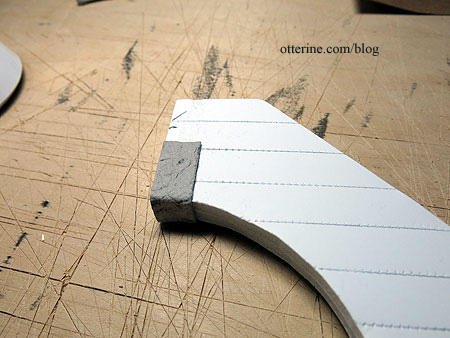
For the stones around the curve, I repeated the process, but I had to taper each piece to fit. Little bow ties. :D
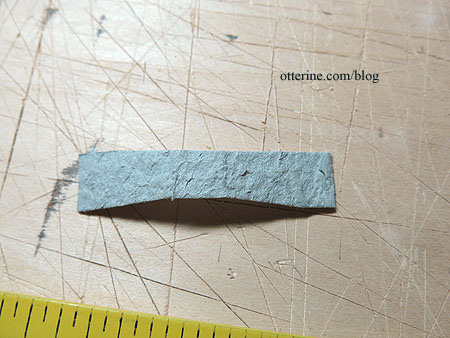
I didn’t take a lot of photos during the process since I applied and removed stones many times as I figured things out. The second wall should be much easier, and faster! Here’s the arch after completion showing the tapered stones and tight fit.
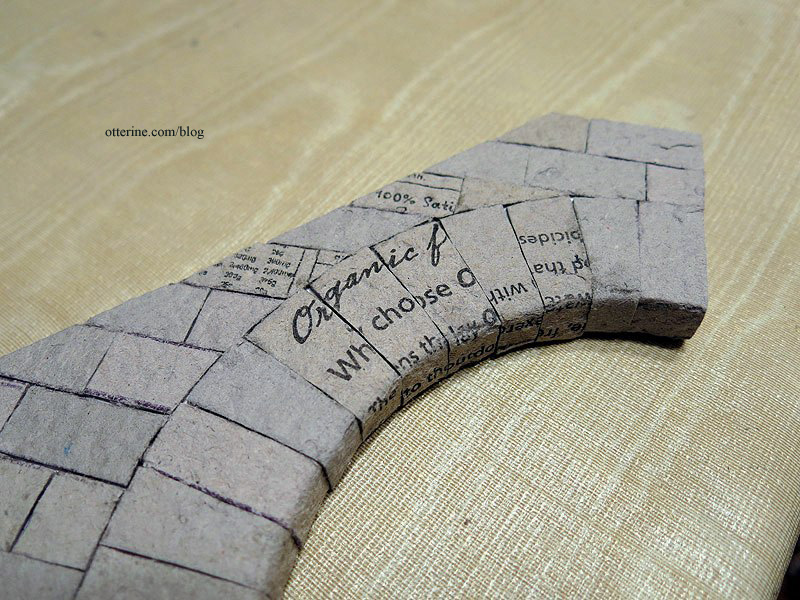
Since there was an uneven amount of space left at the bottom of the arch, I added a large block instead of having a small stone at the bottom. This is also egg carton material and follows the same process as the other wraparound pieces.
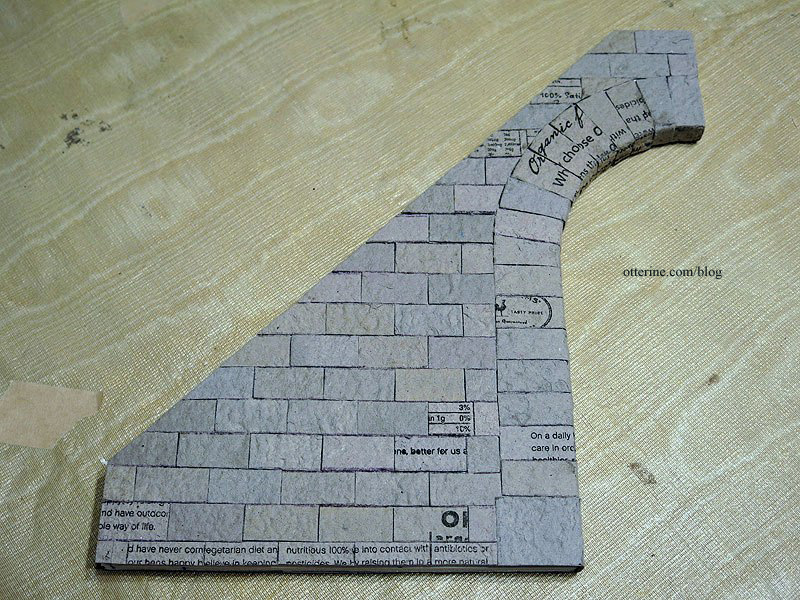
Once these were in place, I started applying the straight rows from the top down. Partial stones can be more easily disguised at the bottom with landscaping and accessories. I will finish the tops with basswood painted to resemble concrete, so I cut the stones flush with the angled top. I also pressed the stones close together since I don’t plan to grout other than adding filler where needed.
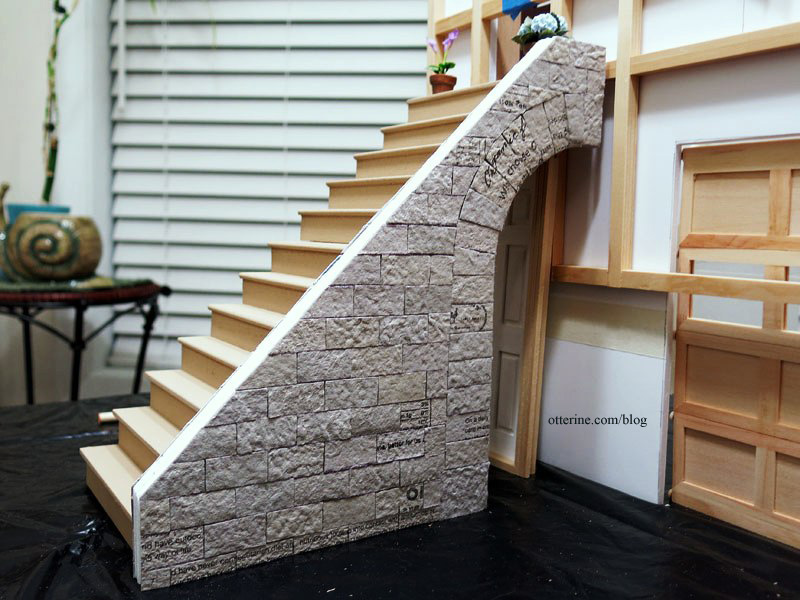
Since you will be able to see most of the other side, I repeated the stone application to match.
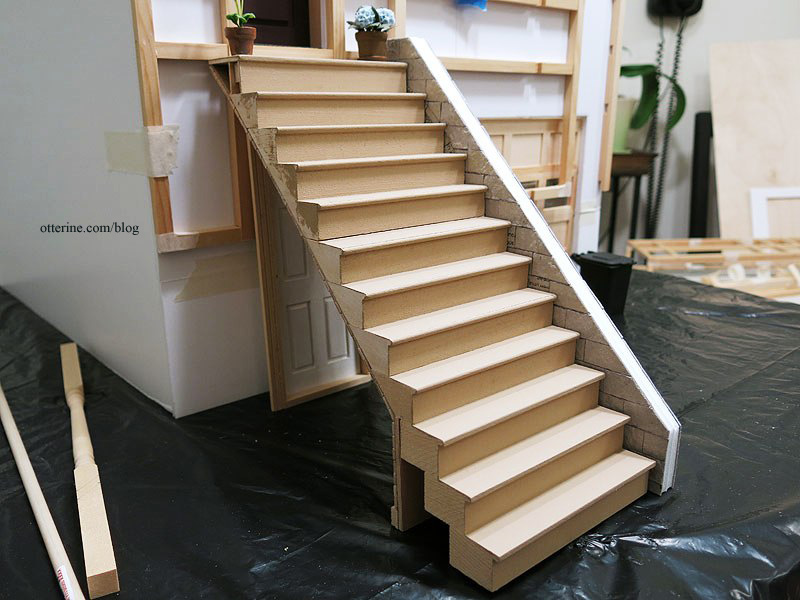
With the skinny sticks and stone finish, I think the trash bin nook will be fabulous! :D
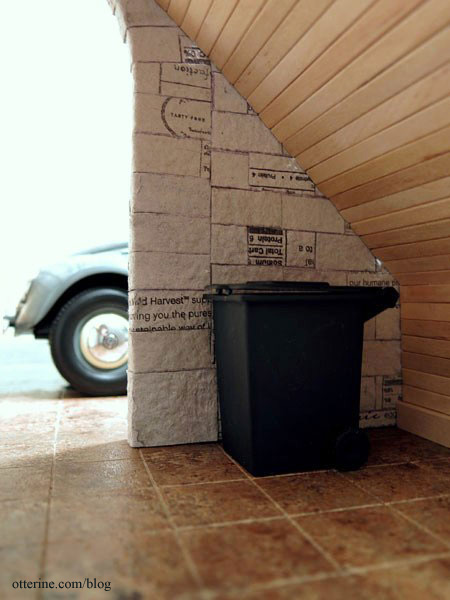
Categories: The Brownstone
February 5, 2014 | 0 commentsThe Brownstone – entrance and front steps, part 5
Continuing work on the entrance and front steps. The side walls will be covered with egg carton stones. I printed guidelines, with the top section measuring 1/2″ and the subsequent sections measuring 9/16″. I will be stacking the stones very close but wanted to give myself a little room. I taped the guidelines to the foam core assembly, trying to make it as square as possible.
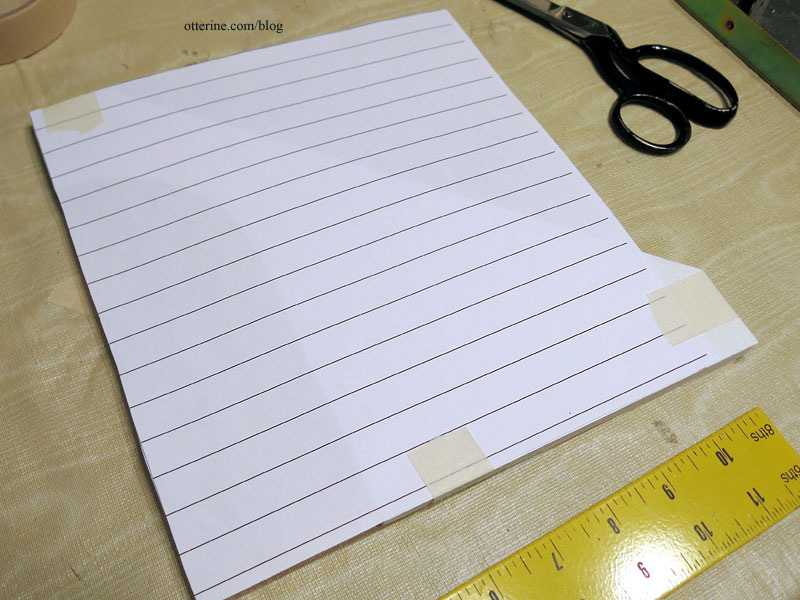
I used a tracing wheel (sewing tool) to transfer the lines to the foam core board.
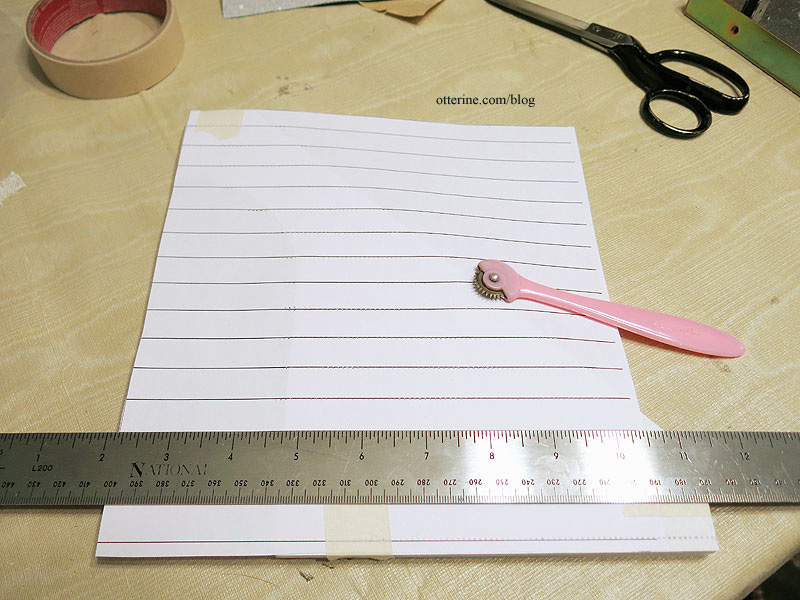
I then used a pen to enhance the lines.
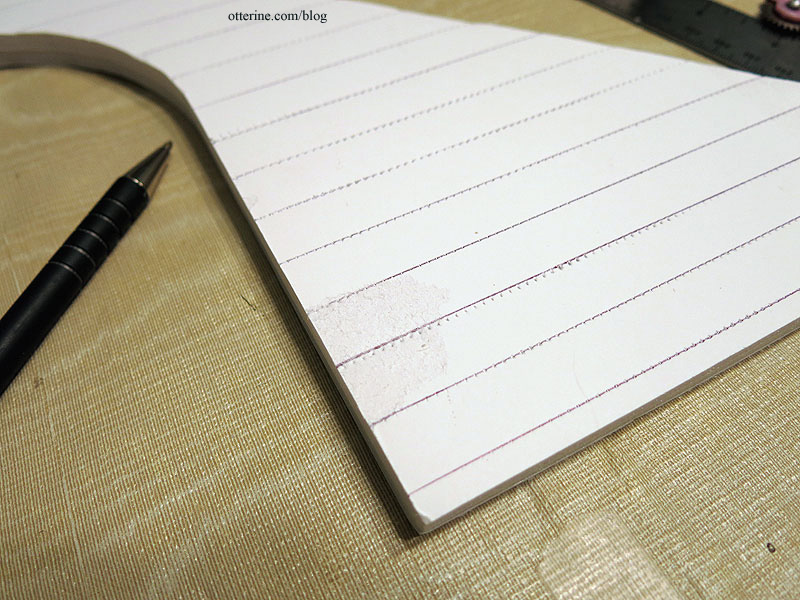
Since I will lose my staircase placement lines when the stones are put in place, I transferred the markings to the foam edges with a Sharpie.
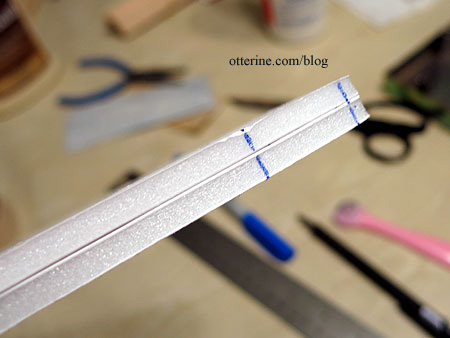
To finish the back of the staircase, I added a scrap of plywood behind the top vertical step piece.
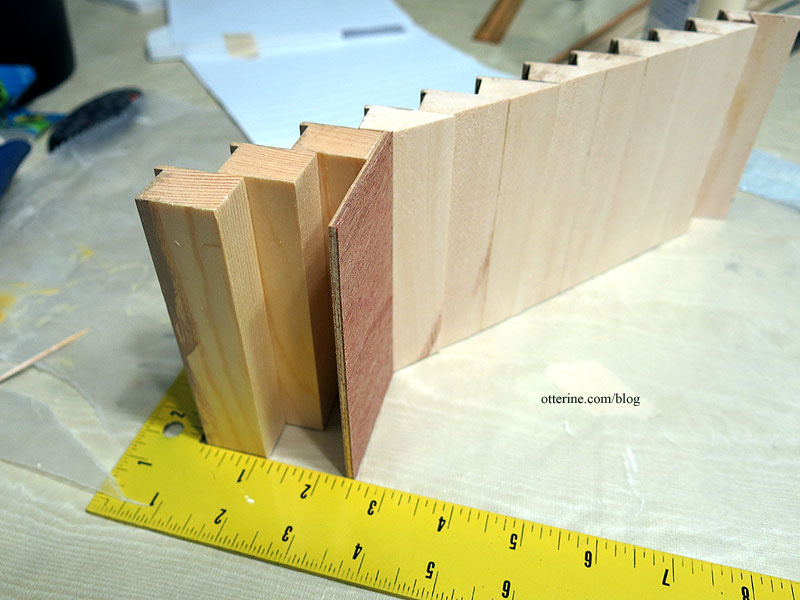
I then added a cardboard liner to the back of the angled section to have a uniform surface for applying skinny sticks.
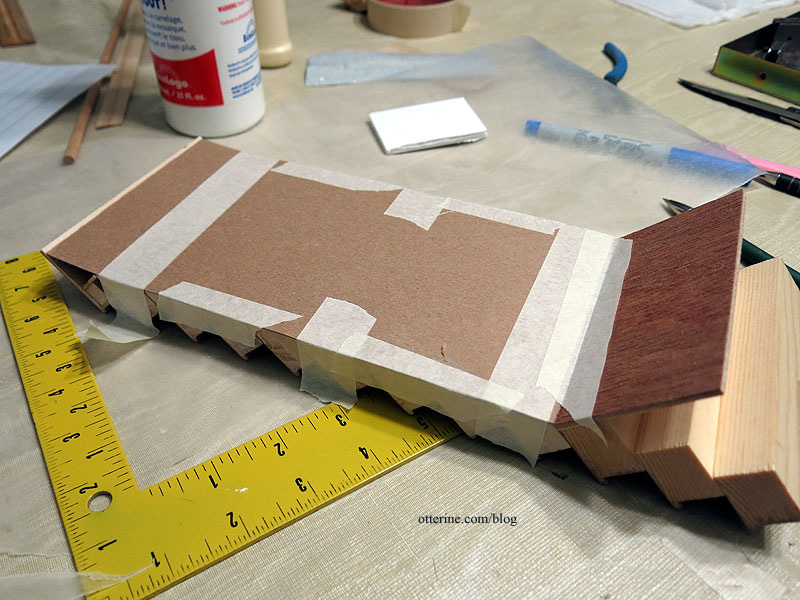
I save my scraps of foam core board to use as glue spreaders. They are inflexible and have a good straight edge for moving the glue around uniformly.
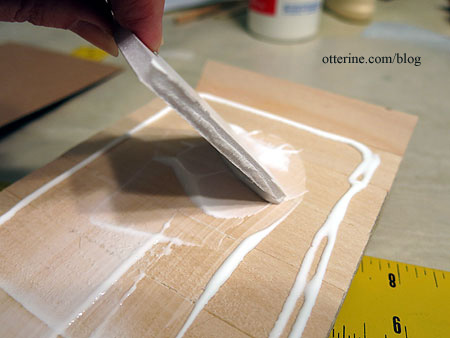
I cut the sticks and glued them in place, taping the boards down until glue set.
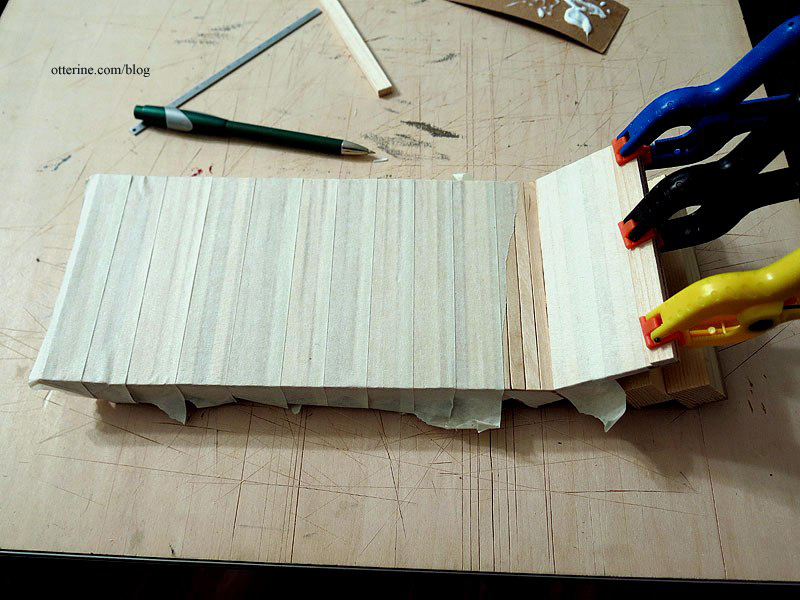
I finished the bottom edge with 3/8″ basswood. Now I have a nice clean, finished surface.
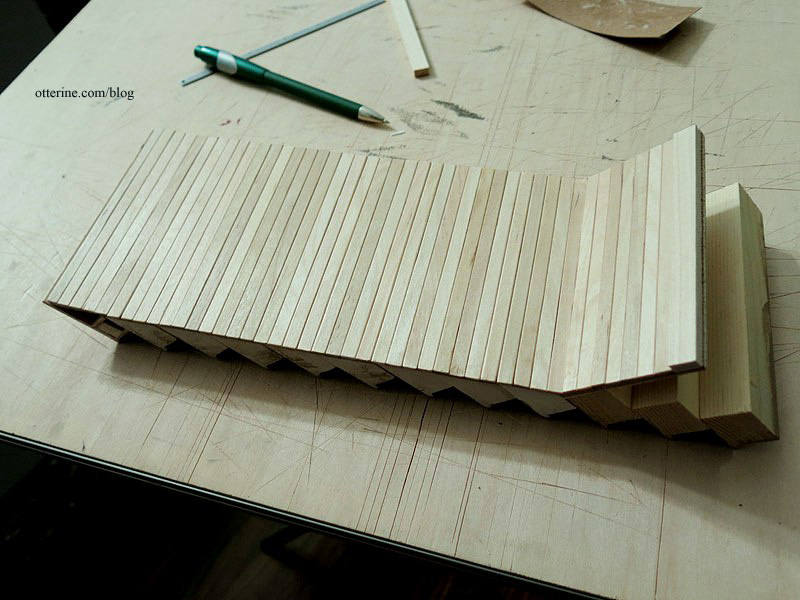
Categories: The Brownstone
February 4, 2014 | 0 commentsThe Brownstone – entrance and front steps, part 4
Continuing work on the entrance and front steps. I made a new top step/front porch from plywood and basswood.
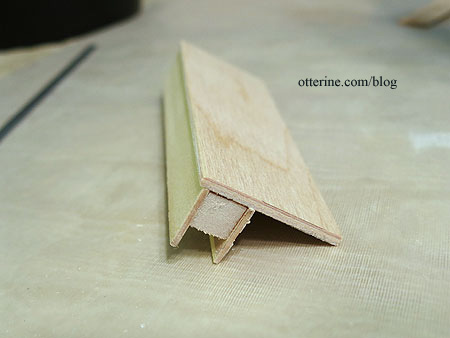
I glued this in place on the top trim molding step, having marked the depth on the top of that piece previously. Since this will be enclosed, I put some masking tape on the back at the join (not shown here).
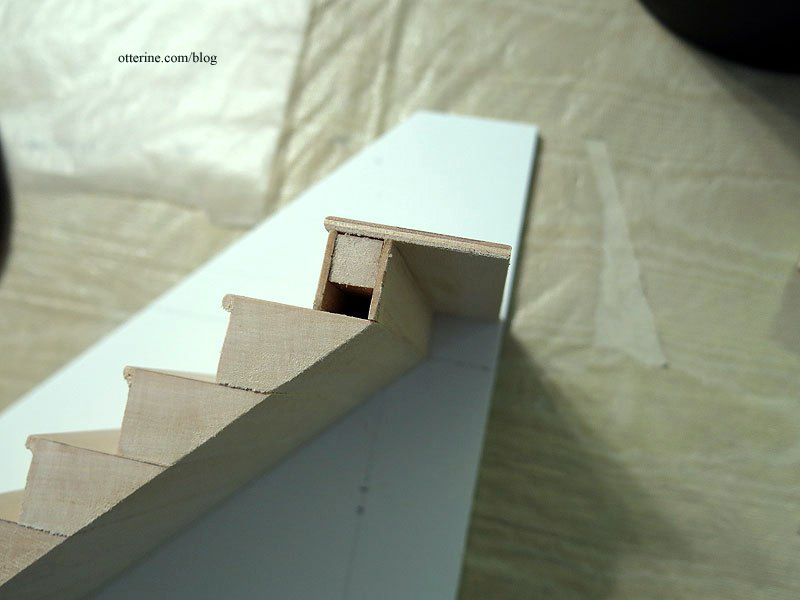
Debora suggested I reconsider the railing to have a more open look and sent me a photo showing an example I hadn’t seen. All the railings I had seen involved intricate wrought iron work. It hadn’t occurred to me to use a basic iron railing that could be made from wood dowels.
I cut down the side walls, creating an open space between the railing and the side wall. This will significantly cut down on the expanse of stone on the side walls, making them less intrusive overall. And, it looks like I’m back to porch columns instead of brackets. :D
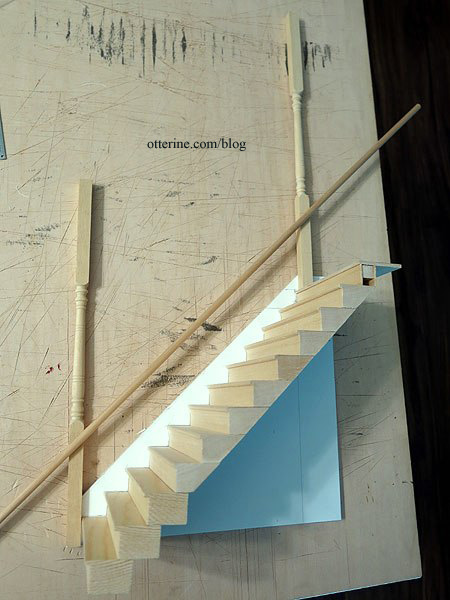
I used a plastic lid to make the arch under the stairs and cut the opening with the scroll saw.
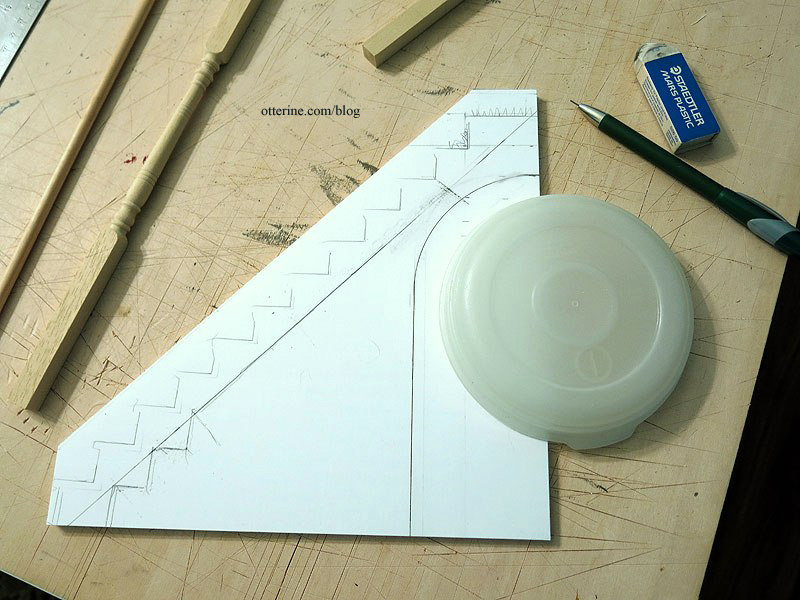
I measured the arch to allow a person to walk through to the side lawn and to accommodate a door on the front of the building.
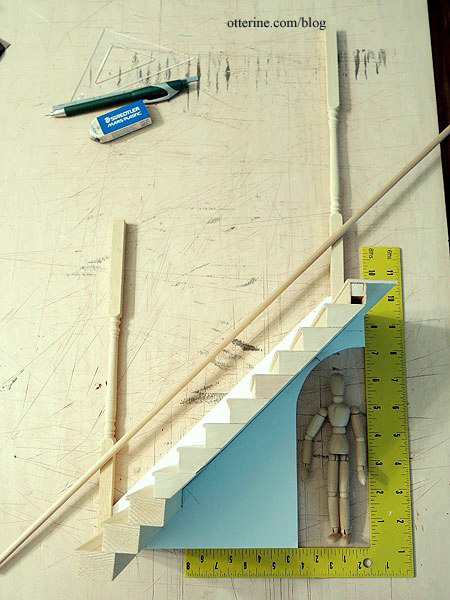
I cut three additional pieces of foam core board following my initial template.
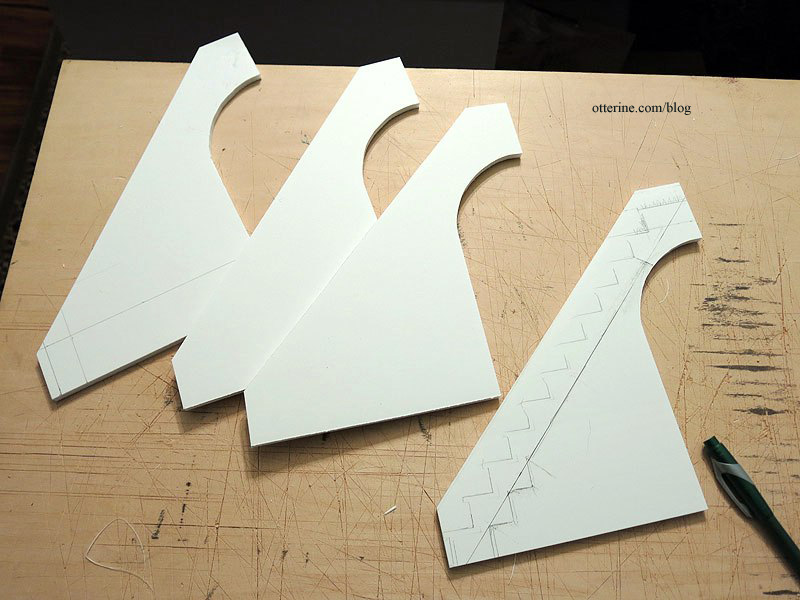
I glued two pairs and transferred the relevant markings from the first board to the opposite assembly.
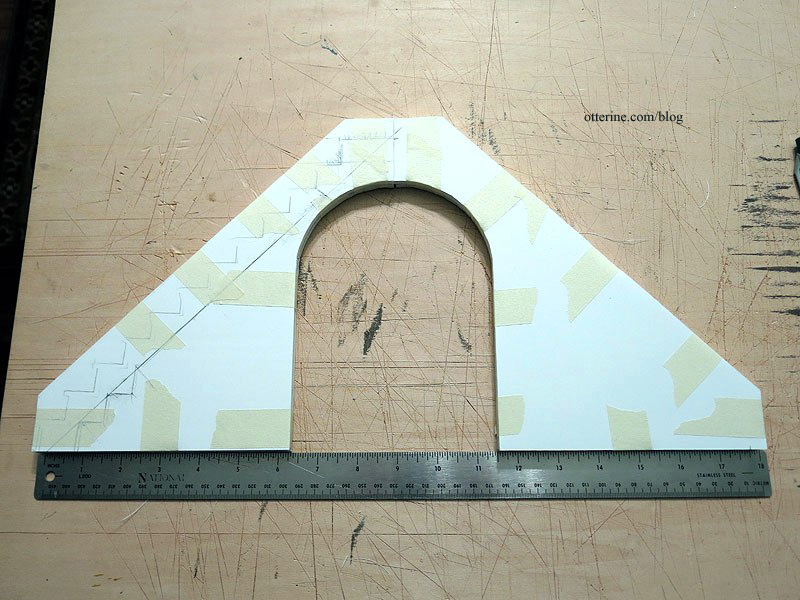
I painted the stairs Fawn by Americana.
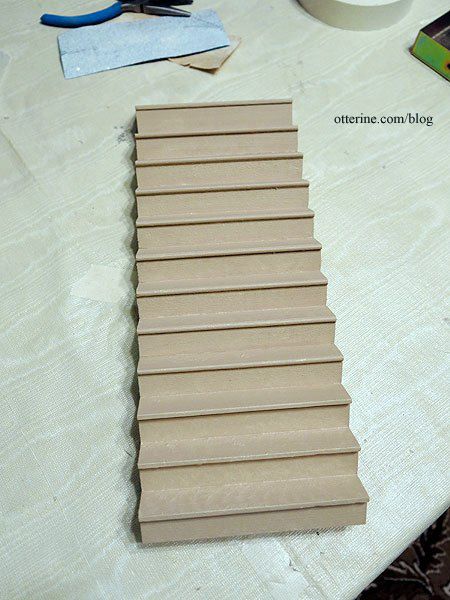
When I put the stairs in place, they were roughly 3/8″ lower than the doorway, as expected. But, I now think this works well. Having a step up into the doorway is a common feature from what I’ve seen. Happy accident. :]
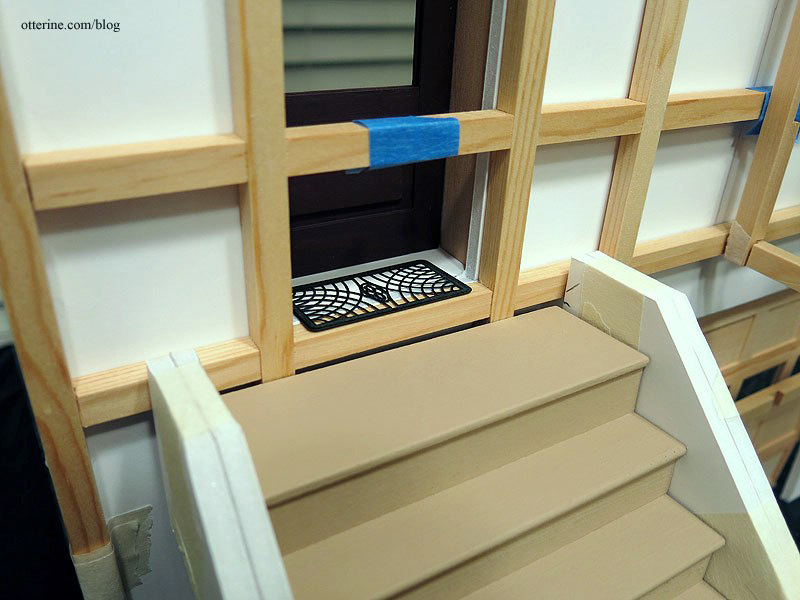
I taped the posts and railing in place. Keep in mind these will be more aligned later, but I don’t want to cut the materials until I am ready for them.
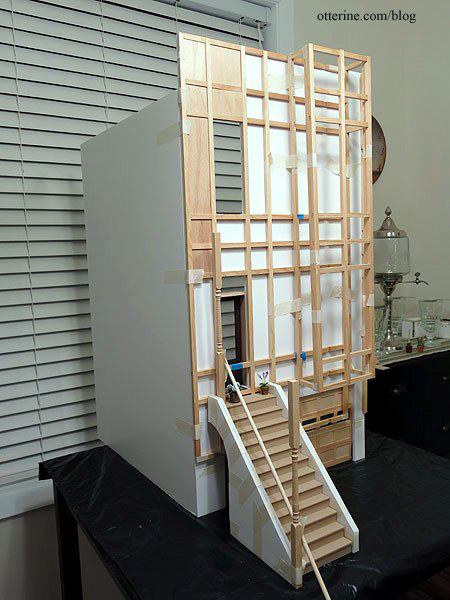
I think these changes add a lot of visual interest.
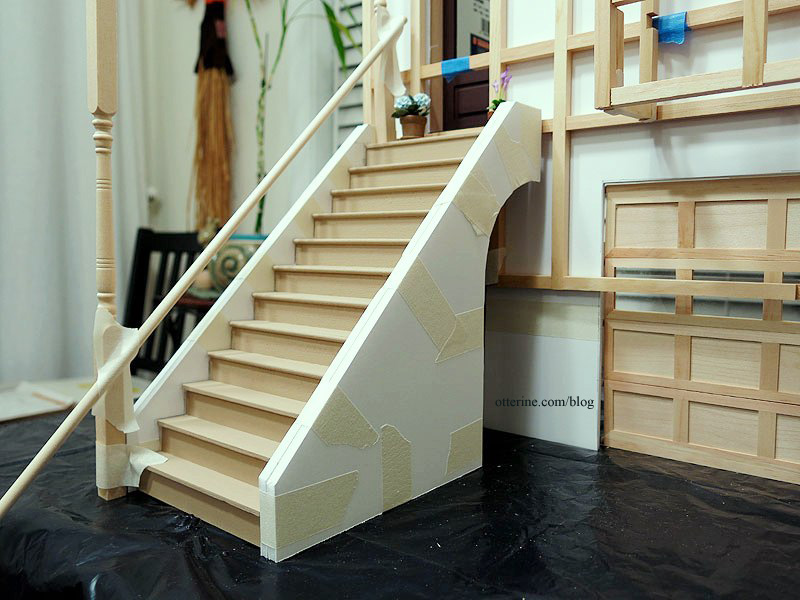
And, at first, I was going to close up the back of the stairs and have a full arched tunnel. Then it occurred to me that this would be the perfect hideaway for trash cans. :D
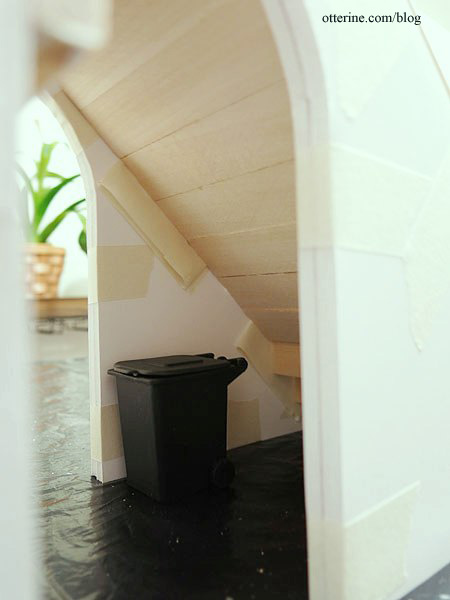
So, that means two separate stone walls on either side of the steps. I’ll figure out a way to finish the back of the stairs…probably skinny sticks. This will actually be easier for construction. Under the arch, there will be a door for the lower floor.
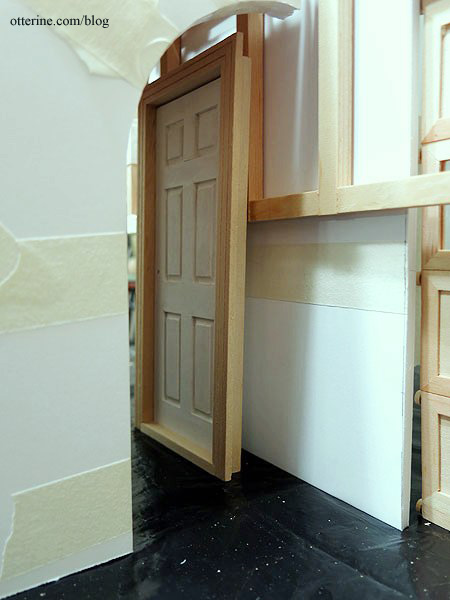
Categories: The Brownstone
February 2, 2014 | 0 commentsThe Brownstone – entrance and front steps, part 3
Continuing work on the entrance and front steps. I glued three of the original kit steps to the bottom of the assembly of eight trim molding steps.
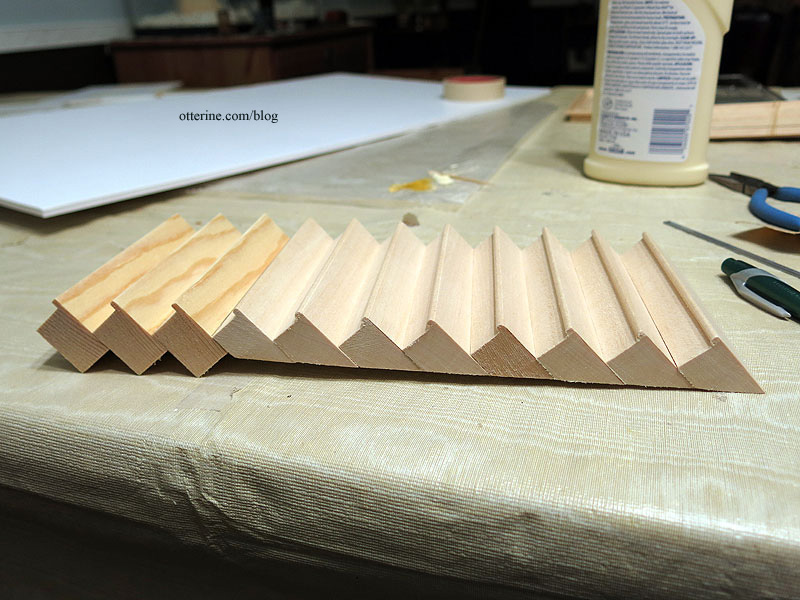
To make sure they were evenly spaced to match the top steps, I drew guidelines on the tops before gluing.
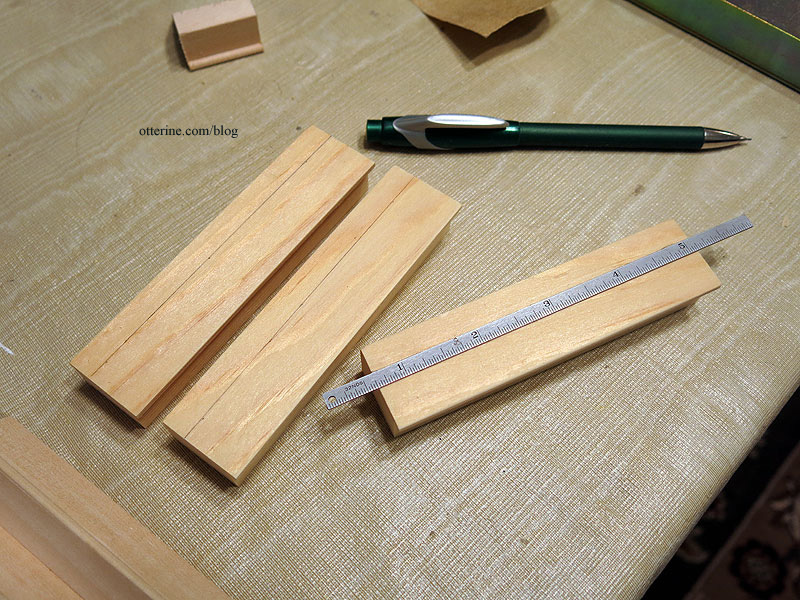
I drew guidelines for the top stair/porch assembly that I will build later.
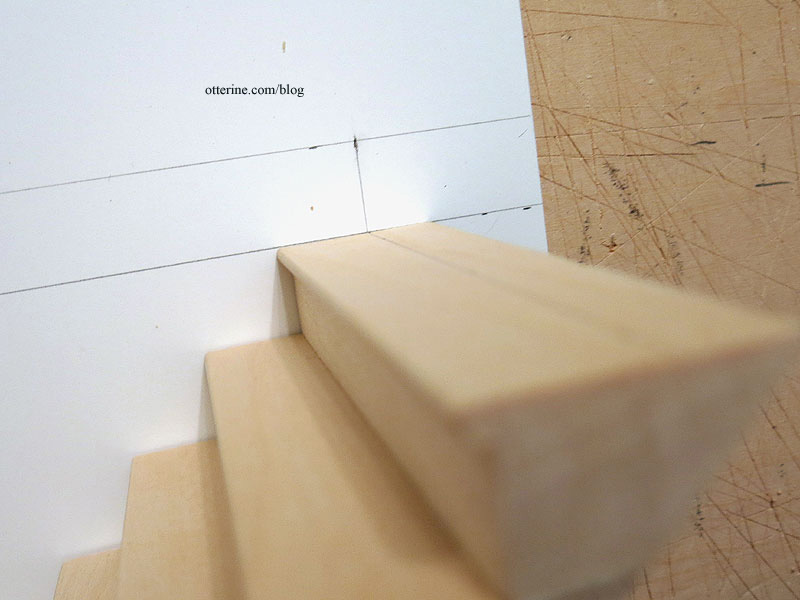
With the existing steps, I am short 3/8″ under the stairs. I don’t want a huge top step, so I will build up under the bottom step with the modest amount of sidewalk that will show. I marked the side boards to reflect stone walls on both sides that would also serve as railings. There’s very limited room under the stairs so the arch and doorway will have to be carefully planned.
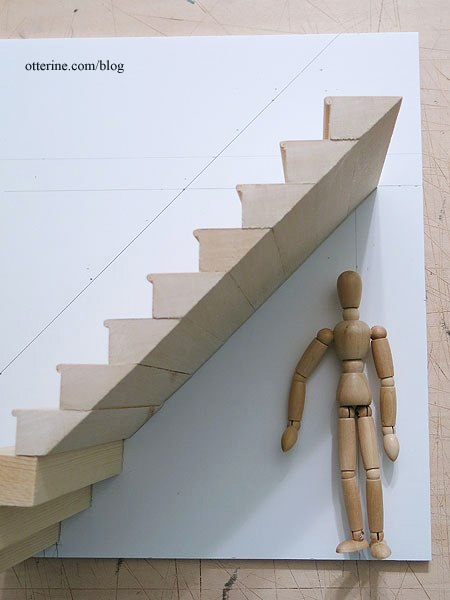
I might opt for a shorter wall with opening railings, but I want try something new. Here’s an example of what I have in mind. :]
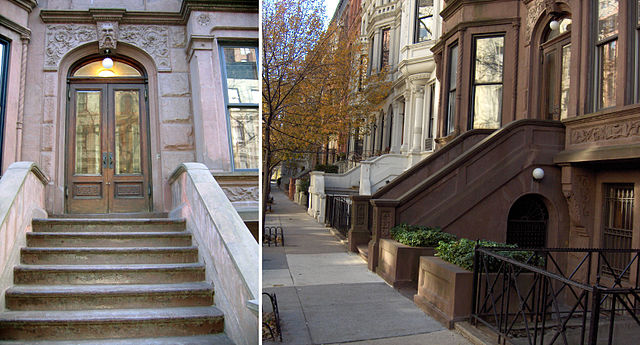
image from Wikipedia If I go with this, I will cut new brackets for the canopy above the door and eliminate the columns. Scroll saw to the rescue! :D
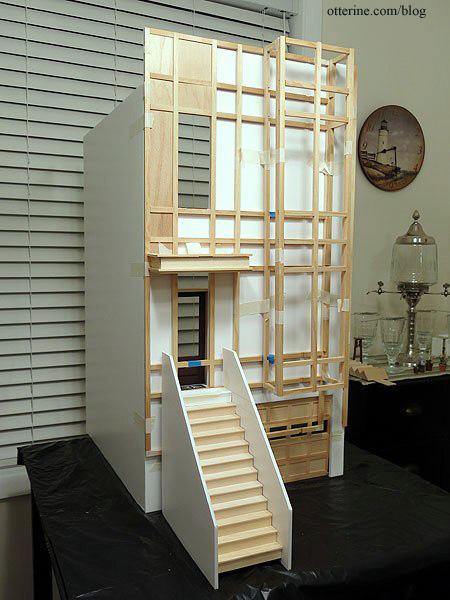
As I mentioned, I liked April’s idea of having plants on top of the portico, so I tried raising it up as Debora suggested. I think it will work, especially since I plan to leave the open space above the door as a window. I won’t convert the upper window into a door, because I don’t plan to make this space large enough to be a balcony, just a place for plants, and a mini person could simply reach through the window to water them. :D
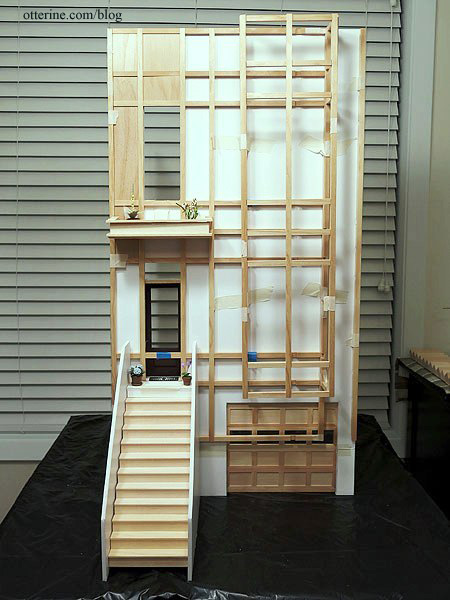
Categories: The Brownstone
February 1, 2014 | 0 commentsThe Brownstone – entrance and front steps, part 2
You know it’s a good project when you keep other people up thinking about solutions. :D Many people had good input on the entryway issues, but I believe April gets the gold star. She made a mockup of the entryway in the The Sims 3. haaaaaaaaaaaaaaaa! :D
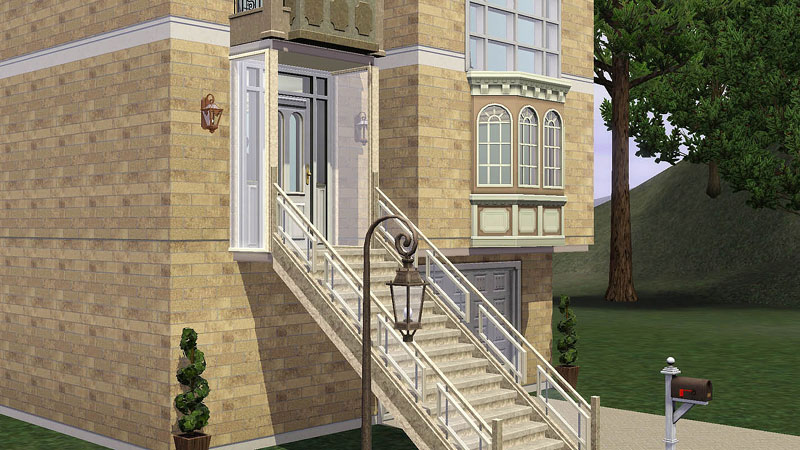
She suggested I go with the first option of adding a small porch, pushing the stairs forward. After sleeping on it, I had come to the same conclusion (great minds thinking alike!). I do have room on the interior, which means I can cut down the depth of the building to make up for the amount I add to the front porch. I won’t be cutting my final side walls until the front board is further along anyway.
I started by dry fitting the portico roof. There’s some interesting construction going on here, and I’m figuring this was to keep the kit costs down. The basic roof assembly is fine; there’s quality wood and it’s precisely cut.
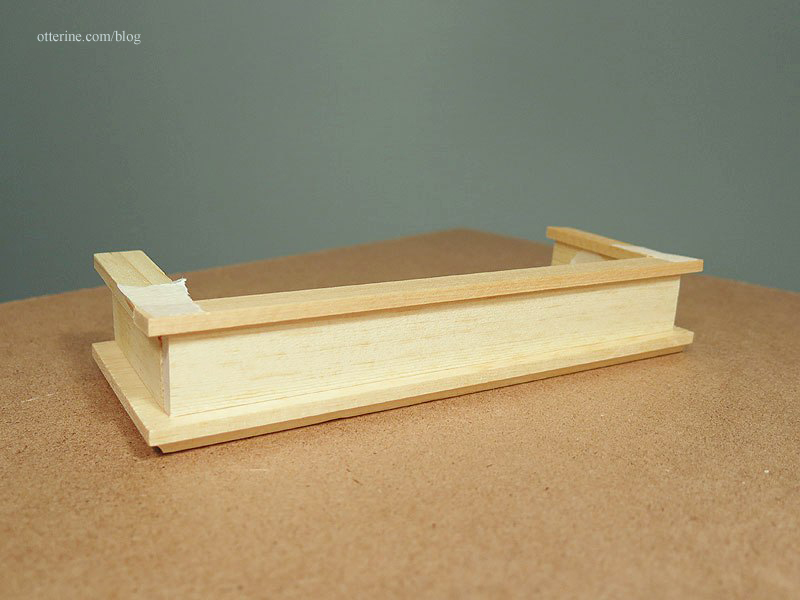
They have you make the flat molding detail by gluing on tiny precut bits of wood. Uh, yeah, that’s not gonna work well. I foresee purchased fancy trim in my future.
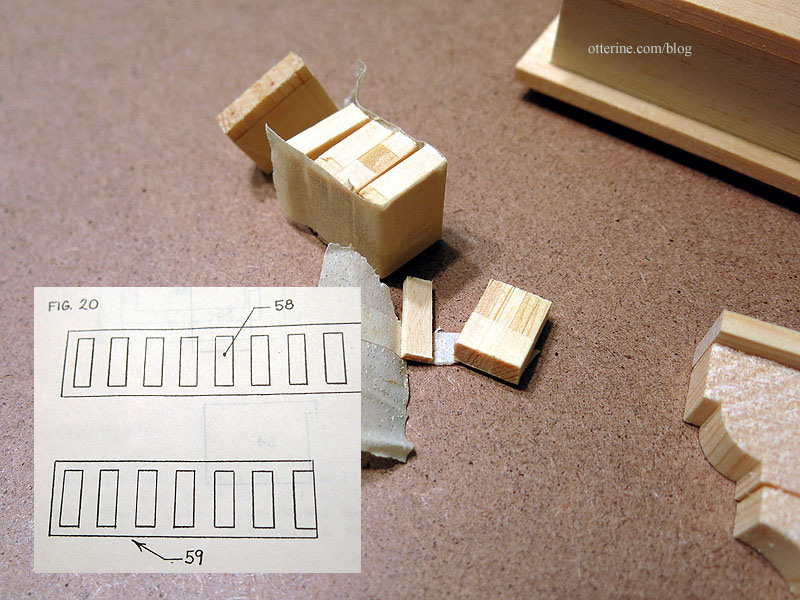
The brackets are the worst, though. You assemble each from three poorly cut pieces and then paint on the detail. I might not go with brackets anyway, but if I do, these will be replaced as well.
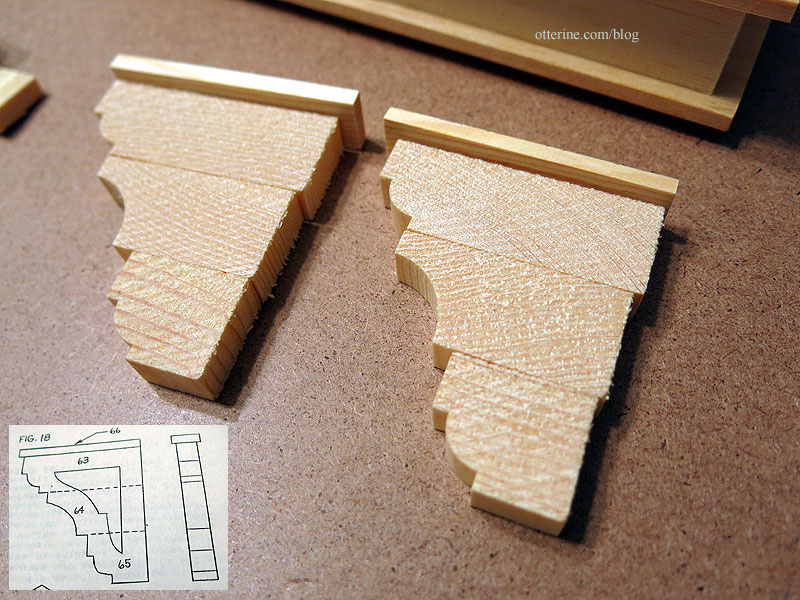
On to the mockup. I cut the holes in the foam core board facade for the upper window, front door and garage door. I wanted to see the recessed door in relation to the new porch. The blue taped piece is to be cut out according to the kit instructions to open the doorway, but I am leaving all grid pieces intact until I’m ready to work on them.
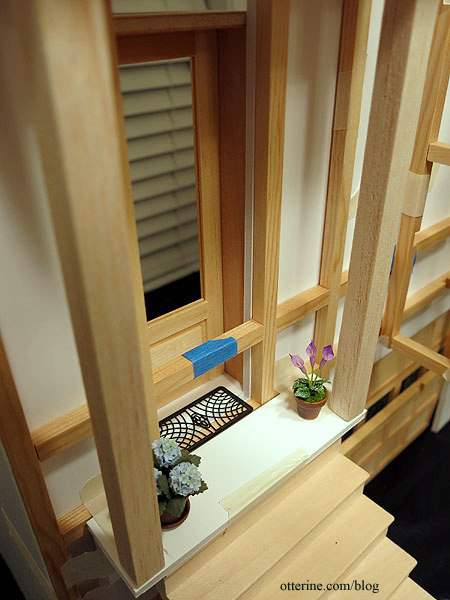
I’ve had the hydrangeas for awhile, but the calla lily is from miniatures.com. I borrowed the laser cut doormat from The Haunted Heritage. I have another of these for the Brownstone, and it looks like it will be a perfect fit. It’s from The Dolls House Mall and started out as brass. :]
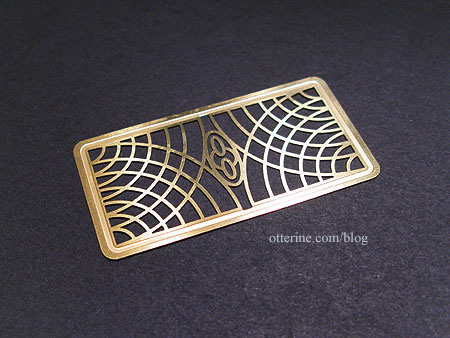
Now, I’ll be using 1/8″ thick plywood for the facade base and the foam core board is 3/16″ thick, but none of this will matter in the end. I’ll be modifying the opening for the working door frame and can alter the way this portion is constructed to get it all to work. :]
I added two balsa wood columns that won’t be used in the final design, but I do like the idea of columns here instead of brackets.
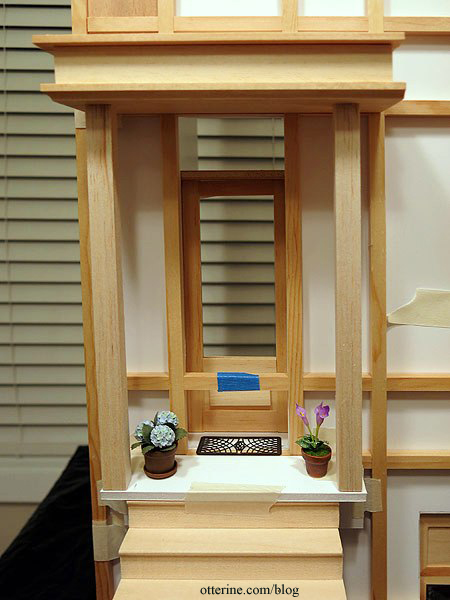
For the porch, I used a piece of foam core board 5 5/8 wide by 1 1/2″ deep. I have the top stair taped directly under it for now. I will build up the porch to act as the top step, and build up the landscape underneath the staircase to make up for any difference in the end result.
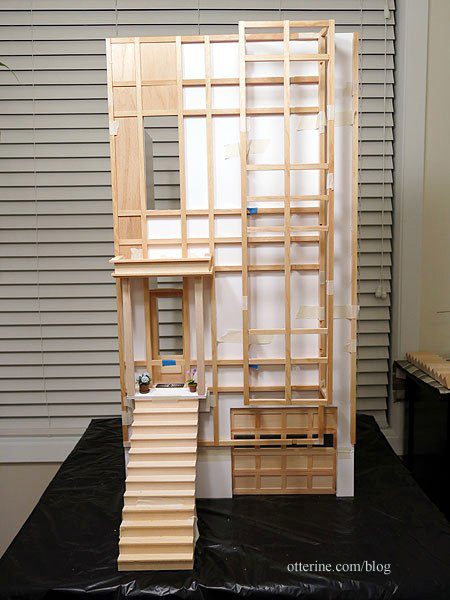
I’ve also been throwing around the idea of having a door to the basement/garage area under the front stairway. I think an arch under the staircase would make for wonderful curb appeal, too. I’ll address the sides of the stairs next.
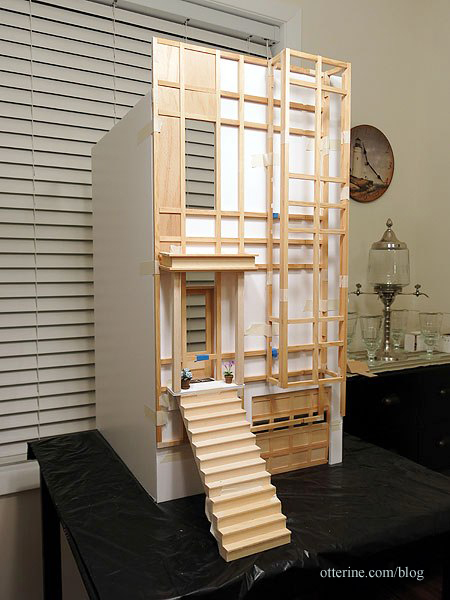
Even though April’s mockup isn’t based on the Golden Gate View kit, it was exactly the kind of visual I needed. Huge thanks to April! Woohoo! :D (I love the plants on her balcony, but alas, there’s too much room between the upper window and the portico roof.)
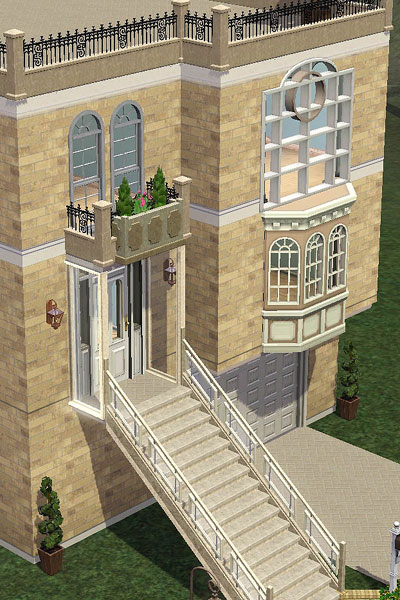
Categories: The Brownstone
January 31, 2014 | 0 commentsThe Brownstone – entrance and front steps, part 1
Update on The Brownstone. I tend to keep my bashed builds in dry fit a long time, because while I can think of a lot of things that will come up along the way, there are always things I don’t think of, problems with materials or a change in direction. The facade has to be the first thing I do overall, but there are a lot of parts to it.
I will keep the bay windows and upper window the same as the original kit, but the front entrance needs some consideration. I’d like to keep the original kit door if possible, and it needs to be assembled from pieces. If I do keep this door, then I need to figure out a way to make it a working door, which will in turn change the way the recessed entryway is constructed. The kit instructions have you glue the door in place, but I want a functional door. So, I can’t cut my new facade backer board until I figure out the entryway in dry fit.
You can see from the drawing how this door will look with all the trim in place. The plywood surround creates the recess, but the door fills the whole interior space…there’s no frame.
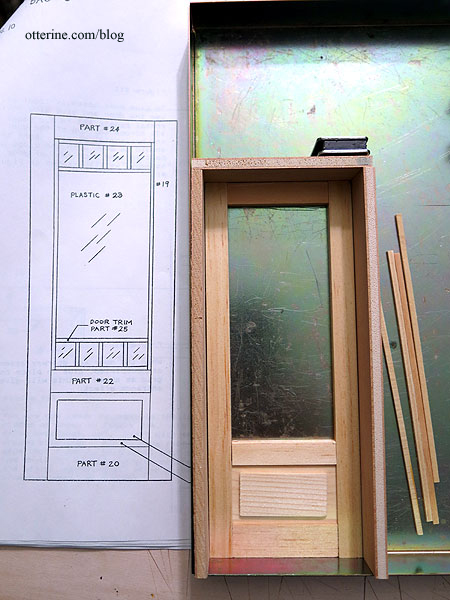
The Houseworks door I have as a backup plan is shorter and narrower than the original door, so I’m going to try to get the original to work. The original just says “row house” to me. :]
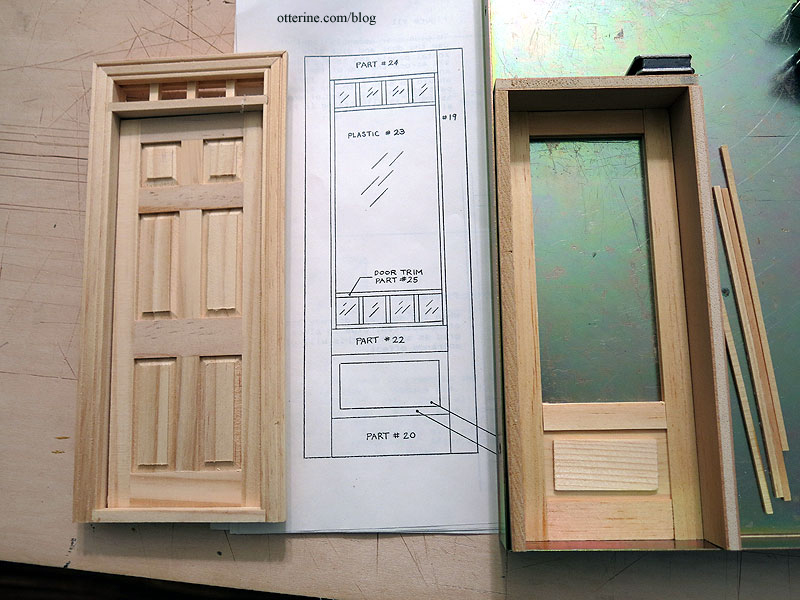
I pretty much need to address the front steps at the same time in case I want to make further changes to the entryway based on the stairs layout. With the added height to the bottom of the building to accommodate the garage door, a new front staircase needs to be constructed since the kit steps will be too short.
I bought some stair molding from Manchester Woodworks so I could cut my own steps. The original stairs are 3/4″ tall whereas the trim molding is 11/16″ tall, but it’s such a small difference that I will use the kit stairs and the trim molding stairs together to make the taller staircase.
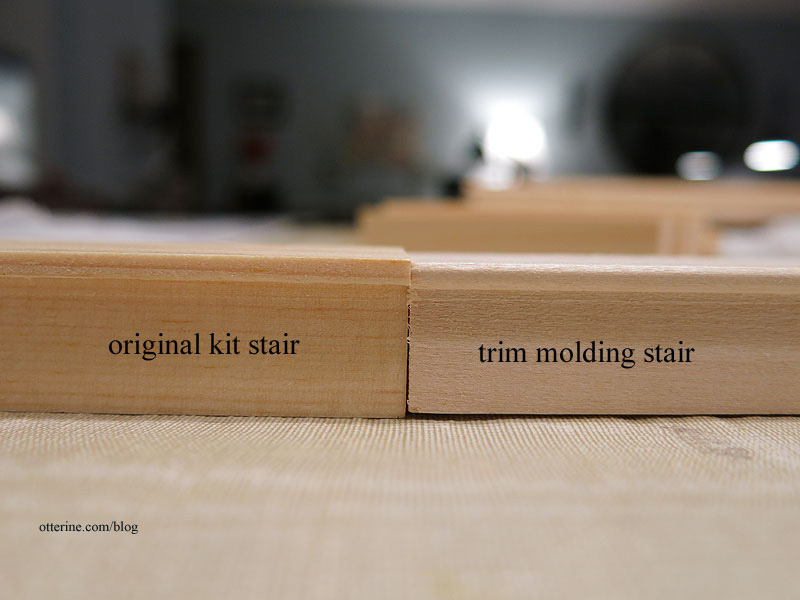
The kit stairs are 4 1/2″ wide, so I cut 8 new stairs from the molding using this measurement and glued them together as a set. I’ve left the bottom three kit steps separate for now but taped them in place to check the fit.
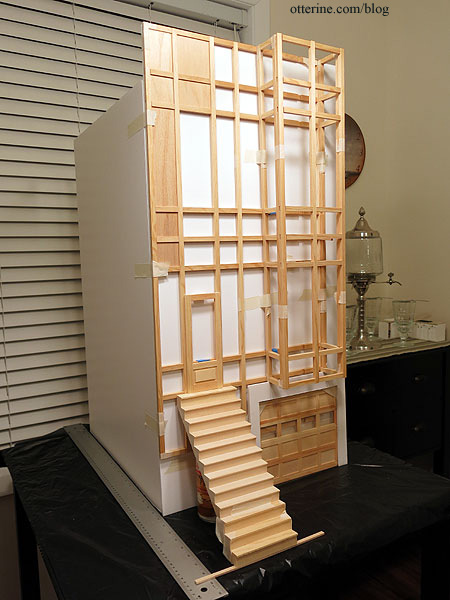
I also propped the smaller top step from the kit in place.
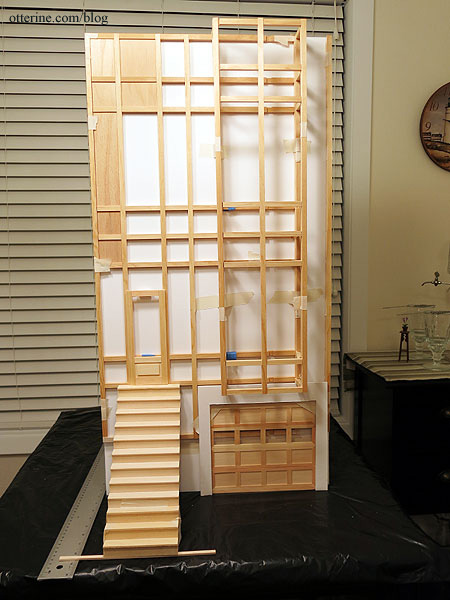
It certainly looks better than the skinny steps I used in the first mockup.
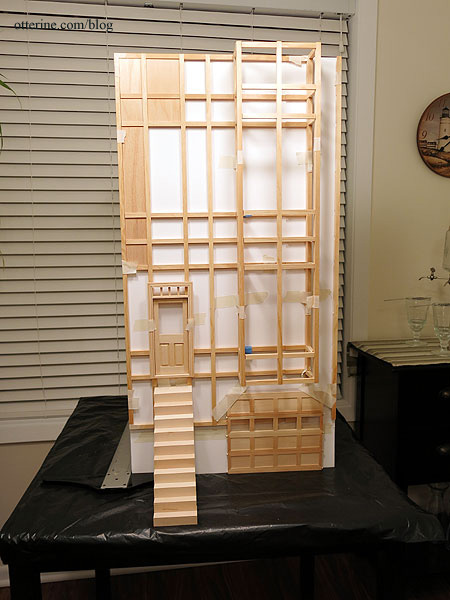
Mike on the Greenleaf forum has a wonderful drawing of the Golden Gate View that shows the construction better than the small kit box photo. One thing I don’t like is there is no front porch to speak of; the recess in the doorway is essentially the porch. Not what I want at all and not very realistic. I mean, where’s the postal carrier going to leave packages? :\
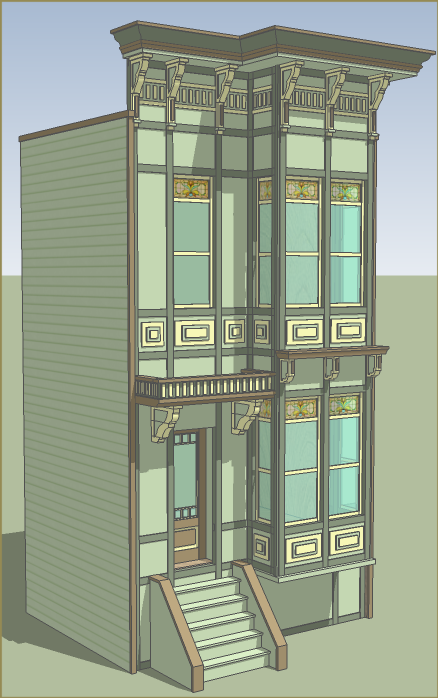
I have two choices: add a modest front porch board that will push the steps forward or I can alter the front wall to push the entrance back into the building. I really don’t want to add any more depth to the landscape board than necessary. This build will have next to no lawn, because I don’t think its necessary for the style. Leaving 1-2 inches of ease around the building should be sufficient for transport and display. If I add a porch board to the front, I just make the footprint larger.
So, that leaves pushing the entrance back into the building. I do have some room to move the interior stairs back, so I think that’s what I’ll mock up next.
Categories: The Brownstone
January 30, 2014 | 0 commentsThe Brownstone – foam core board mockup
Update on The Brownstone. The kit instructions have you assemble a grid from vertical and horizontal notched pieces, as you have seen in previous dry fit photos.
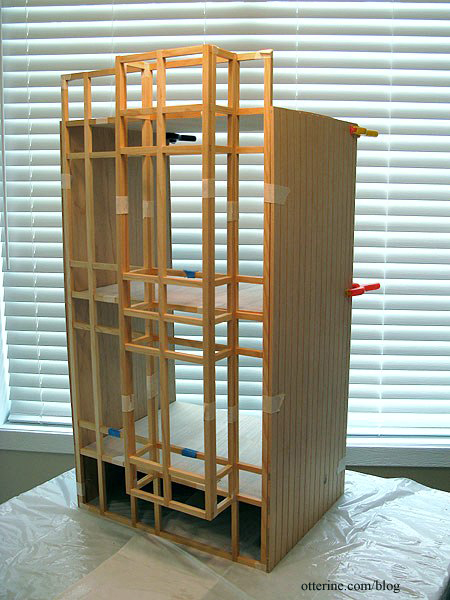
Later in the build, you add pre-cut inserts to complete the walls.
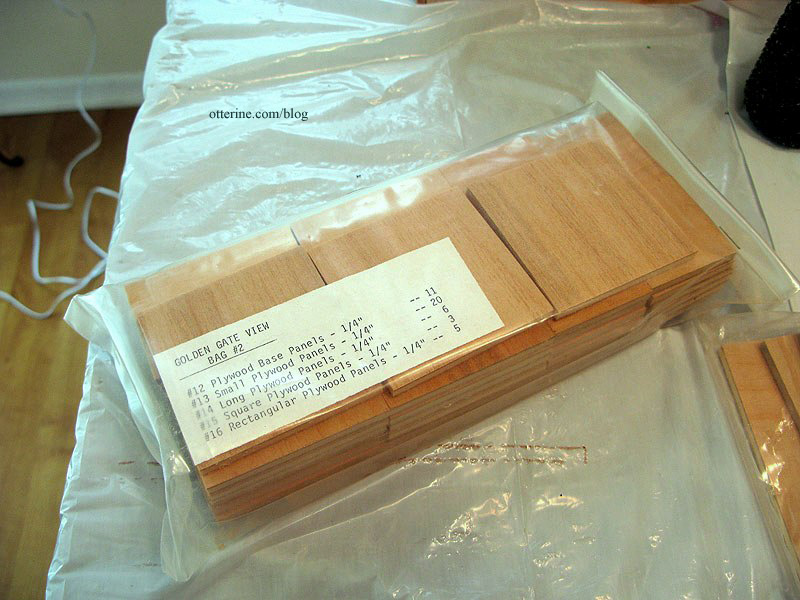
Since I need to add some width and height to the facade, I’m going to approach the assembly in a different manner as well. I’ll start with a full board cut to size. I had to piece the foam core board but my final wood panel will be one solid piece. To this front panel, I will add the grid trim and finishing inserts. I will trim the bottom of the grid flush with bay portion since I’ll need the lower portion open for the garage door.
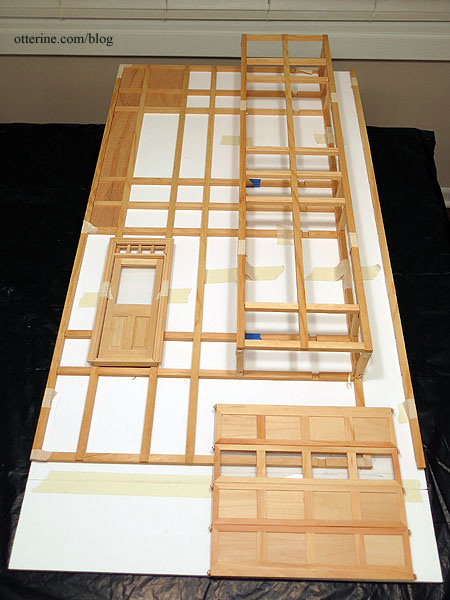
A few inserts worked just fine. As I noted before, I would think it prudent to use these as spacers when assembling the front wall and bay window grids to make sure it all fits precisely, but the instructions don’t have you do this. The grid is tight because there are notches to match up on the verticals and horizontals.
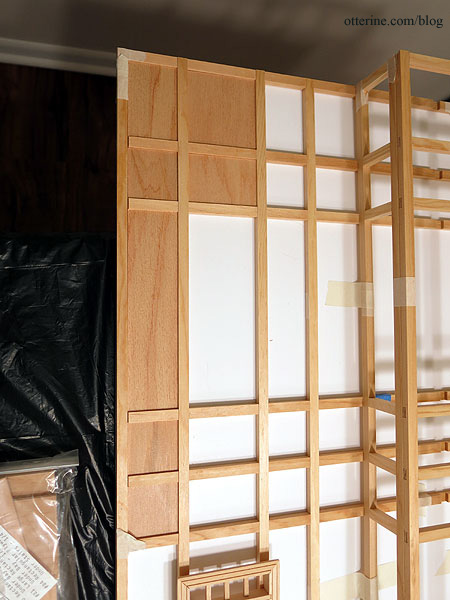
And, a few brought forth my least favorite phrase: “sand to fit.” I foresee some issues later on. I have to cut new pieces for the added width anyway.
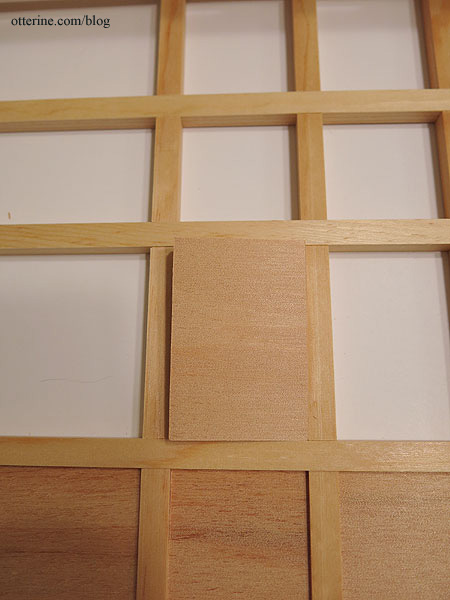
Having a solid front board allows for a smooth surface on the interior and a stable base for the front detailing of the structure. This front board ended up being 33 1/2″ tall by 17 1/4″ wide. The build is just shy of knocking into the ceiling light fixture above my work table. Whew!
I’ve used the interior stairs kit just as a trial. I have some supplies ordered for the new staircase. The front door will also be recessed and not floating in space. The original kit has a portico top, so there will be good visual interest here.

The next step was determining the depth I will need to fit the rooms and accessories I want. The garage needs to be at least 16″ deep to accommodate the Beetle comfortably, but this is the least of the issues.
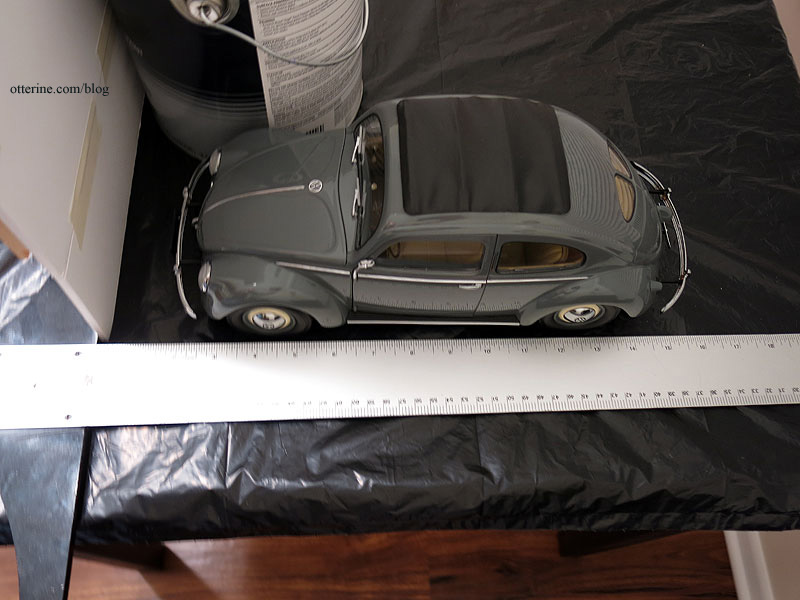
The side walls are shorter than the front in the original kit as well, so I started with a piece of foam core board 30″ tall by 20″ deep.
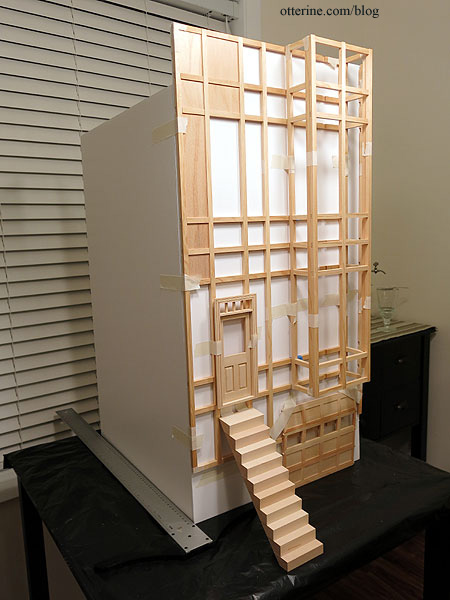
As you can see, I didn’t bother to put in the first floor for the interior layout since the overall shape is a tall rectangle. Each room is the same as the next.
I put the pieces for the recessed entrance of the original kit in dry fit to see how much room this will take up on the inside. Only about an inch. I am going to see if I can keep the kit door, which needs assembly. I will be foregoing working windows to follow the kit construction, but I must have a working front door. There may be some bashing involved here, and I have a Houseworks door (not the one shown in the mockup pictures) as a backup.
From the front door, I want a full staircase to the second floor. I will be using the Architect’s Choice stairs purchased at the 3 Blind Mice show earlier this month. I taped most of the steps together to get a feel for the size. They are 3″ wide before any embellishment, which I am sure to add. I need enough room behind the stairs to add a door to the garage stairs and a door to the side addition. I also need enough room for a realistic landing on the second floor. The 20″ depth seems to be perfect since it will give me some breathing room during construction.
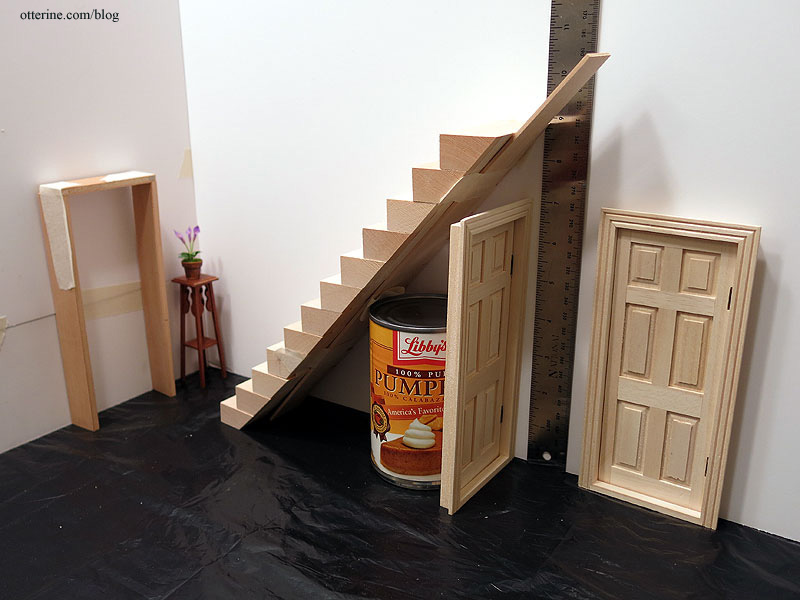
There will be a wall between the staircase and the living room. I borrowed the Newport study fireplace and a Bespaq sofa for placement. The Navajo rug will live in this room permanently, but the other pieces will be replaced.
I borrowed the Baxter Pointe Villa kitchen cabinets since they are out for the remodel of that kitchen. This won’t be the exact layout, but the kitchen can be sizeable with the added depth. I like the idea of a breakfast counter, but there might end up being enough room for a table. We shall see. I like the idea of an open concept here between the kitchen and living room, so I’ll likely add only what support is needed to keep the ceiling level.
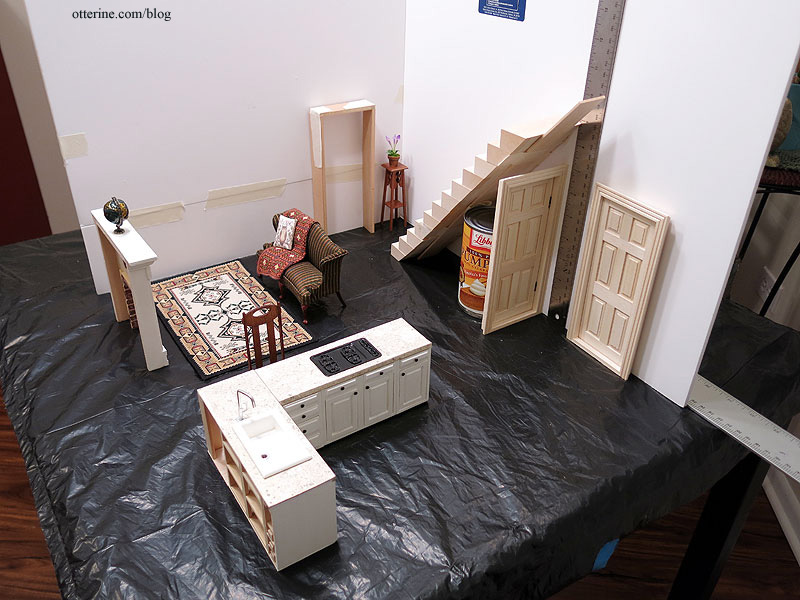
I already know the landscape base board will be deeper than 25″, which is the maximum measurement I use for the shortest side of any build’s base. The reason for this is that I need the builds to fit through the doorways in my house. Yes, the exterior doors are wider to move the builds out if I need to, but I don’t want to be limited to where I can put my finished builds since I don’t have a ton of room in the first place.
So, this meant the width of the landscape board has to be 25″ and that didn’t give me a lot to work with for the side addition. Mainly, I’m looking to add a full bath on the second floor, so I used that as my guideline. I want to make this beautiful bathroom (the warm brown tone bathroom) using the shower set I won in a giveaway by Pepper at MitchyMooMiniatures.
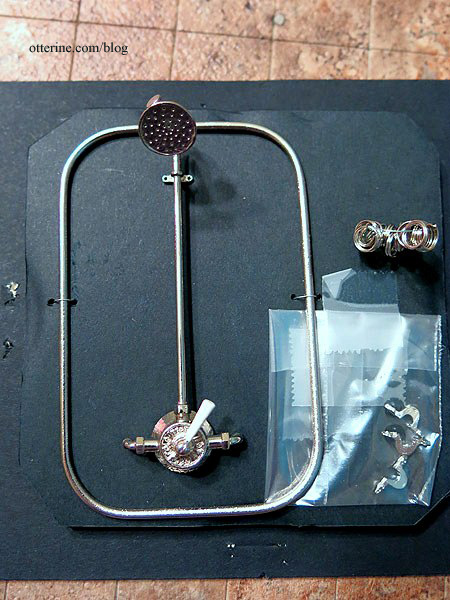
I borrowed the bathtub from the Heritage, the toilet from Baxter Pointe Villa and added the sink from Houseworks. The side addition will be 5 3/4″ wide by 12″ deep. Just enough for a cozy vintage inspired bath.
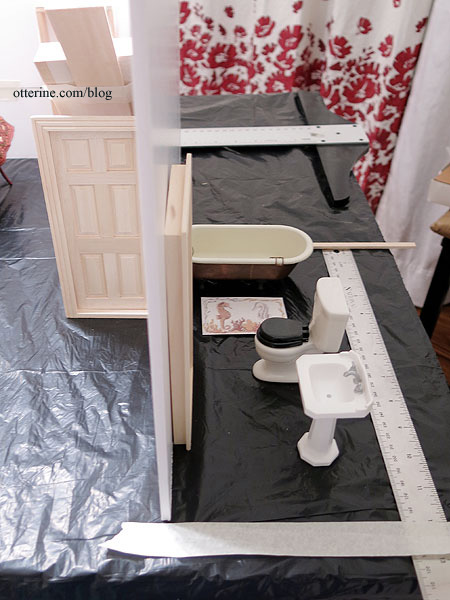
On the first floor, I’m thinking a washer dryer set inside a mudroom. The imagined back door will be in the open back. In the garage, there can be a work room with mini tools. And, if I’m ever going to construct a furnace and water heater, this is the build.
Categories: The Brownstone
January 27, 2014 | 0 commentsThe Brownstone…the beginning
Back in January, I took some photos of the kit pieces since there was some buzz about the Golden Gate View dollhouse kit on the Greenleaf forum.

Golden Gate View kit photo I put it back in the closet, but today I took it back out to take some more detailed measurements. The front wall is made from notched trim pieces with the inserts for windows and walls assembled separately.

The side walls are detailed with vertical siding lines. As you can see, it’s a relatively straightforward kit as far as basic structure goes. It seems some Golden Gate View kits were made differently with studs in the walls, but mine is just plywood.
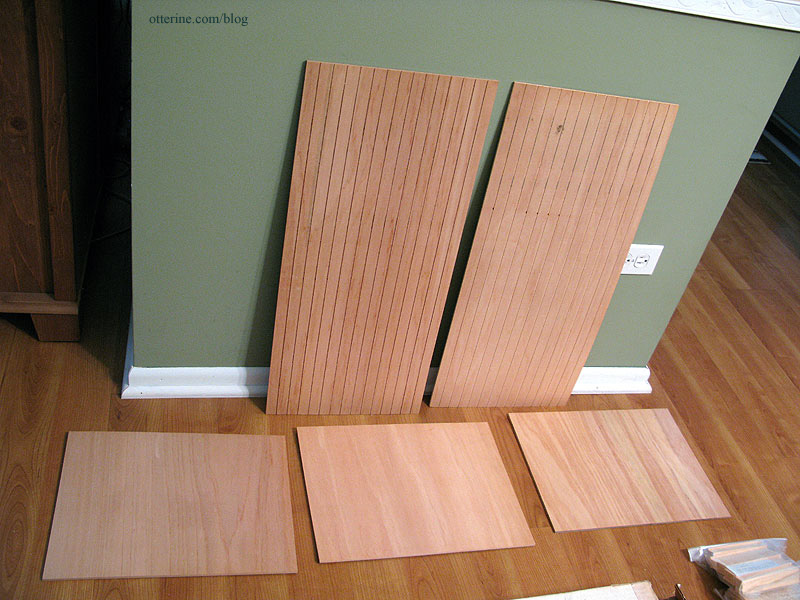
After studying the instructions, I taped together the front wall trim pieces to get a feel for the kit.
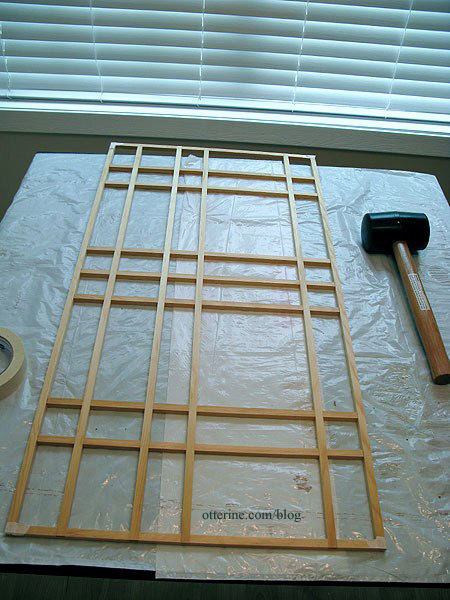
And then the bay window structure.
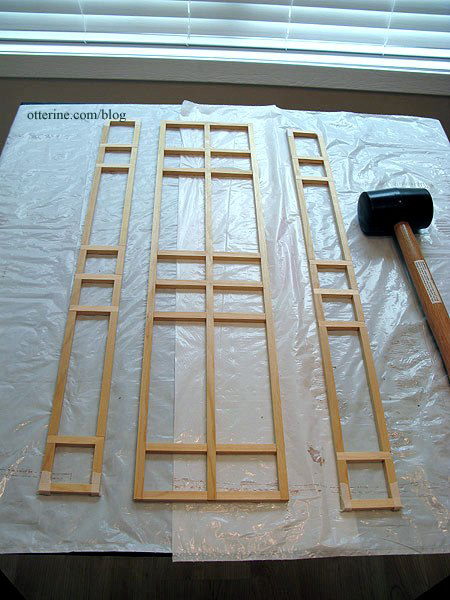
The blue marked pieces are to be cut away during assembly.

Also, the pieces didn’t fit the way the instructions indicated. The instructions show the side walls fitting behind the front assembly, but the floor boards don’t fit properly when you do that. In order for the kit pieces to fit, you have to have the side walls on the outside edges of the front wall. Then the floor boards fit precisely and cleanly. It throws off the design of the front, though. So, I can either cut new floor boards or mask the outer corners with trim.
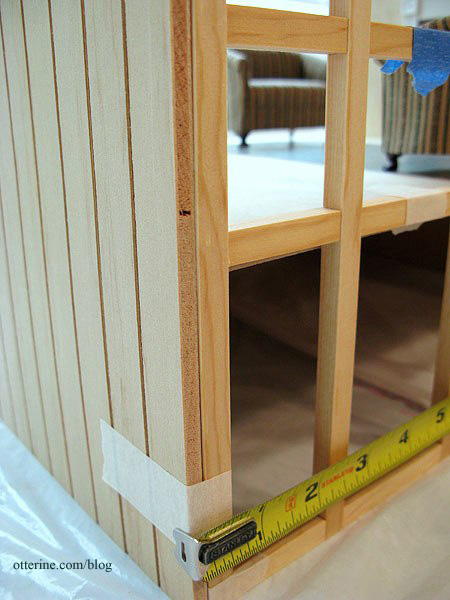
The kit box has incorrect measurements in general and based on the above error. The building in my dry fit is 14″ deep from the outer plane of the front bay window to the back of the building, 15 3/8″ wide with the side walls attached to the outside of the front wall instead of behind it, 29 1/4″ tall at the highest point in front, and 26 3/8″ tall on the side walls.
There are inserts to complete the wall structure. I would think it prudent to use these as spacers when assembling the front wall and bay window to make sure it all fits precisely, but the instructions don’t have you do this. I will likely do it, though and number the pieces as I go along. The instructions also have you add these inserts later after you’ve built the structure, but I think it makes more sense to have a flat surface behind them. So, in essence, I’m pretty much tossing the instructions at this point. Haaa!

The first floor room is roughly 4 1/2″ off the ground. There is no support for it whatsoever…just glued in place on the front and side walls. I will be adding beam structure for sure. The room measures just under 15″ across, just over 10 5/8″ high and 11 1/4″ deep, not including the bay window extension.
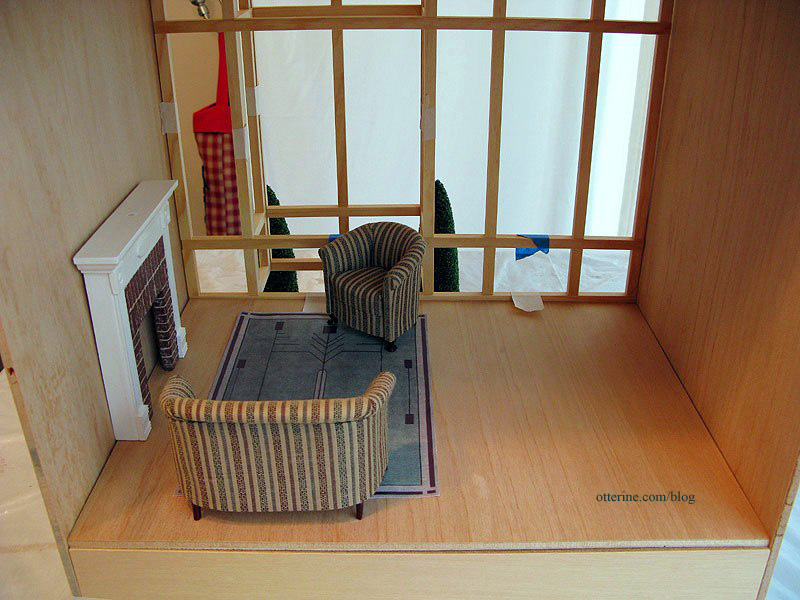
The second floor room has the same measurements. Both nice large rooms
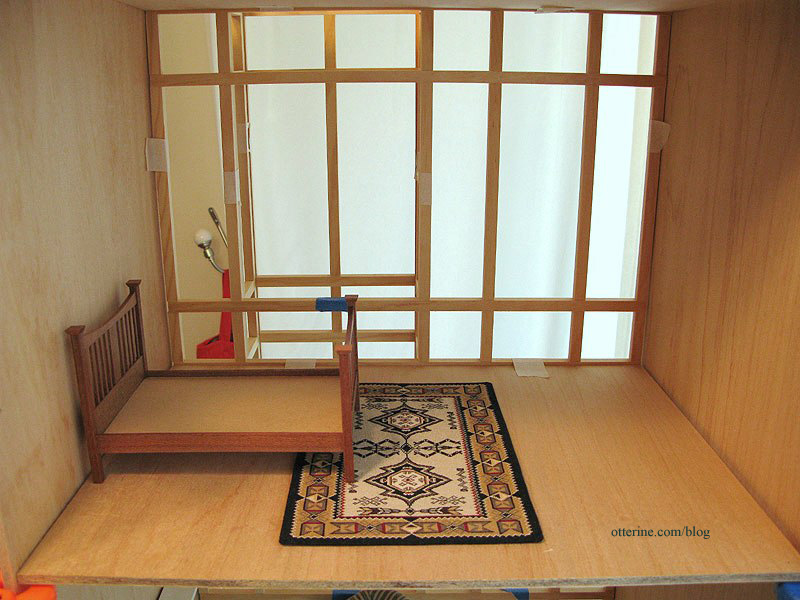
But, two rooms is really not going to work for a realistic brownstone home. At a minimum, I would want a foyer with full staircase, parlor with fireplace, kitchen, bedroom, and bathroom. I would love to add a powder room and/or mudroom.
Option 1 is to build a side addition toward the back to allow more room on the inside, like in this example below. You can barely see the left addition from the front, so it doesn’t ruin the lines of the facade but adds room inside.
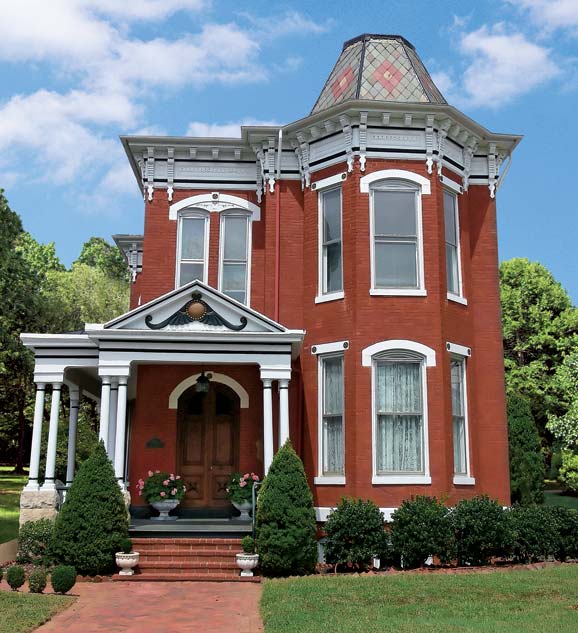
image from Old House Online Option 2 is to add a garage underneath since there is already roughly 4 inches of dead space under the first floor already and adding another 4-5 inches in height would be straightforward.
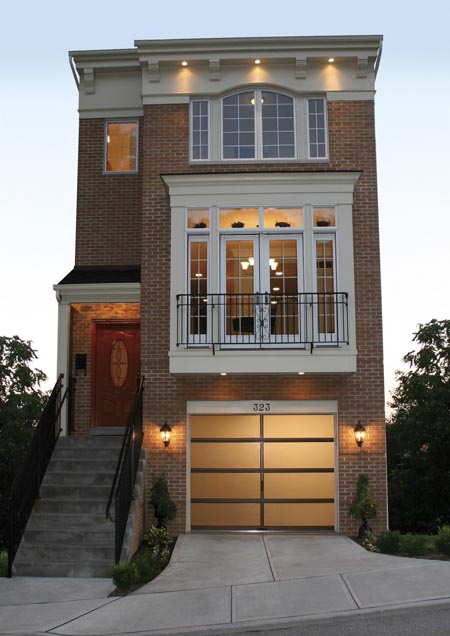
image from Clopay Option 3 is to make this a side opening dollhouse to get more depth like a real life row house. That’s where I stalled. I’m just not falling in love with the idea of a side opening house. Apparently I’m a traditionalist when it comes to dollhouses. I like the idea of the garage and need the extra space inside, so I am almost decided on adding to the width with a side extension and adding height for the garage.
I made a mockup for the garage door kit to test the fit for the 1950 Beetle in a previous post.
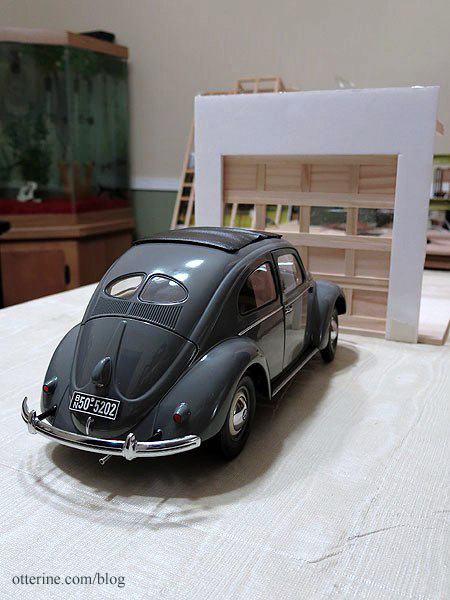
The garage facade and opening required to fit the garage door worked well under the bay window portion, but this did not take the front stairs into consideration. Now, I know I will have to make a new set of stairs since the original kit pieces will be too short with the added height to accommodate the garage, but I will keep them roughly the same width. I would have to move them over to fit the garage door, and this throws off the line of the front door.
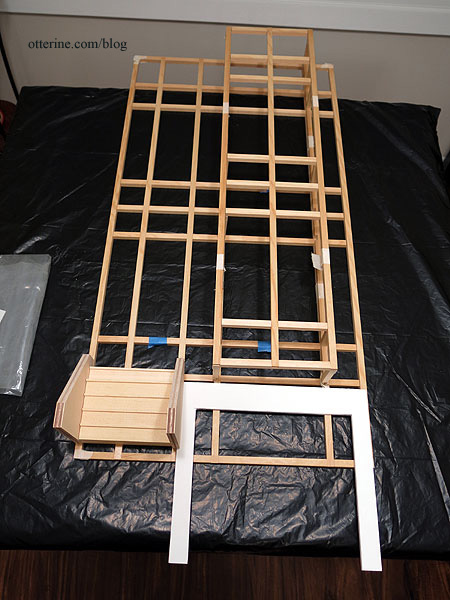
I popped off the bay window section and moved it over. I will have to add to the right of the bay window section, mimicking the construction of the original pieces (I added some strip wood below to show that addition). Now, the garage door is centered under the bay window and there is enough room to center the stairs and front door.
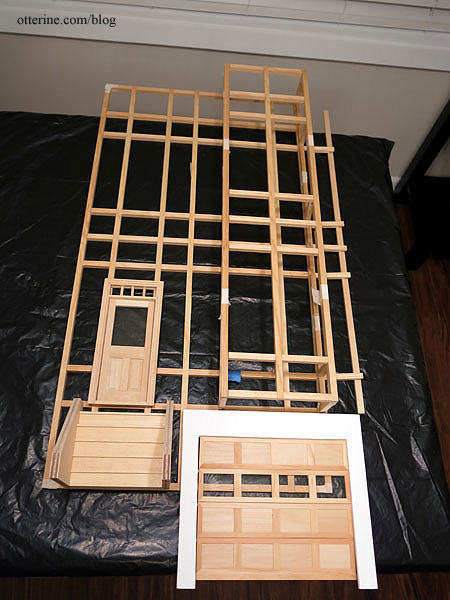
I think I’m on to something here.
Categories: The Brownstone
June 8, 2013 | 0 commentsGolden Gate View
I recently stumbled across an old (albeit new in the box) kit no longer made: Golden Gate View by American Craft Products. I could not pass it up for its unusual design, its relatively compact size and the price. :D

I’m thinking a Brownstone with a two-story efficiency apartment, though I am not sure if it will be contemporary or vintage or some mix of the two.
Categories: The Brownstone
December 13, 2011 | 0 comments
NOTE: All content on otterine.com is copyrighted and may not be reproduced in part or in whole. It takes a lot of time and effort to write and photograph for my blog. Please ask permission before reproducing any of my content. (More on copyright)

The Brownstone – timber grid, part 3
Continuing work on the timber grid. The front wall of the main structure was made from the original kit grid, with the grid pieces measuring 11/32″ wide by 5/16″ deep and the filler pieces measuring 1/4″ thick, leaving 1/16″ of the grid depth exposed. The front wall of the side addition was made from purchased basswood, with the grid pieces measuring 5/16″ wide by 5/16″ deep and the filler pieces measuring 1/4″ thick, also leaving 1/16″ of the grid depth exposed.
To cut down on the overall width of the structure, I approached the side walls differently. For these, I used grid pieces measuring 5/16″ wide by 1/8″ deep and the filler pieces measuring 1/16″ thick, still leaving 1/16″ of the grid depth exposed. I followed the horizontal pattern of the front wall but spaced the vertical beams evenly across the width of the wall. I marked the grid on the side wall of the addition and cut the beams to match. There is no right-hand vertical beam on the side wall since the horizontal beams will abut the corner beam of the front wall of the addition, which will be turned perpendicular when built.

I notched the center beams as I had done for the front wall of the addition.

To get them even, I measured the bottom board first and locked them together in my gluing jig. I then used a triangle and pencil to mark the measurement across all the boards.

I cut the horizontal beams to abut the back vertical beam so I wouldn’t have to spackle the joins on the back surface. I cut filler pieces for the new grid from 1/16″ thick basswood. Cutting thinner wood is easier and faster. That and the lower cost of supplies are the reasons I switched to smaller thicknesses for the side walls.

I bought all this wood from National Balsa because finding 36″ lengths of basswood strips and sheets locally is impossible. They shipped fast, and it’s good quality wood.
I opted to omit windows on the upper two floors since these will be small rooms with interior doors and I need all the wall space I can get. There will be front-facing windows in each upper room (mudroom on the main floor, bathroom on the top floor), so there will be ample light. The bottom floor will have only the basement window on this side.

I’ve filled a few knots and joins in the beam structure so the grid and filler pieces are ready for painting. This particular wall likes to warp, so I ran the plywood board under water and pressed it flat to dry for several days. When it is not on my work table, it is pressed under magazines and paint cans. I won’t let it loose until it’s time for final assembly, which should fix the warp permanently.

With the opening for the front door assembly cut, I could finish the grid for the main front. I slipped the door into the new opening and taped the previous grid in place.

I cut two vertical pieces to finish the sides of the front door and a short horizontal just above the door.

The upper canopy (shown here with foam core board and wood scraps) will disguise the fact that these verticals don’t match with the upper existing design. Since the horizontal along the top doesn’t match either, I opted to leave off the horizontal detailing. This makes the door panel its own design element.

The overall grid still works as a cohesive design with the front door now a focal point.

I cut filler pieces to complete this section.

Categories: The Brownstone
March 16, 2014 | 0 commentsThe Brownstone – openings and padding
With the new boards cut and marked, I needed to start cutting the openings for the windows and doors. I am cutting them with a utility blade. The thickest boards are 3/16″, so it is reasonably easy and quick.
Since the timber assemblies sit on top of the structure boards, I needed to pad the lower areas that will be covered in egg carton stone. The side addition front has 5/16″ thick timbers, so I first added a 3/16″ plywood layer.

I then added a 1/16″ mat board layer. I could have used 1/4″ plywood, yes, but I was trying to use up the scraps I had on hand. The sides will have 1/8″ thick timber assemblies, so I added a layer of 3/32″ balsa — again using up the scraps I had on hand.

I have a small Timberbrook working basement window from All About Miniatures that I’ve added to the lower side wall.

Since you can’t take it apart to finish, I decided to try staining it before cutting the opening. If it turned out to be a disaster, I wouldn’t have wasted my time and energy cutting the opening for it (and then have to fill it back in). It worked well. This is Minwax Dark Walnut.

I cut the garage door and lower entry door holes in the 1/8″ thick main backer board. I cut a 3/16″ thick padding board for the lower front (not glued in place yet). This will have egg carton stone covering it.

I cut the opening for the front door and checked the fit. Hooray! :D

I cut the three openings for the bay window section and the single upper window above the door.

Categories: The Brownstone
March 9, 2014 | 0 commentsThe Brownstone – main floor staircase, part 1
Before cutting the final holes for doorways and windows in the main floor, I worked on the staircase to make sure I didn’t need to adjust the ceiling height on the main floor. I’m making the main floor staircase from an Architect’s Choice kit purchased from All About Miniatures at the 3 Blind Mice Show.
The instructions could use a few additional drawings, but I managed to figure out what they meant. These are made for a 9 3/4″ floor to floor measurement. Since I don’t have a building to fit them into, it’s hard to visualize what that means. I think it means from the surface of the lower floor to the top surface of the upper floor. Either way, that won’t work for me since my main floor ceiling height is 10 1/2″ from the floor surface to the ceiling surface.
I have two of these kits, and the lower level will have a shorter ceiling height. So, I took an extra step from the other kit and added it to the main floor staircase. I assembled it following the kit instructions otherwise. I will still need to make adjustments once the structure is built, but my existing plans don’t need to be altered.
I love the look of white stairs with stained treads, so that is the look I’m going with here. I did this style in the Newport.
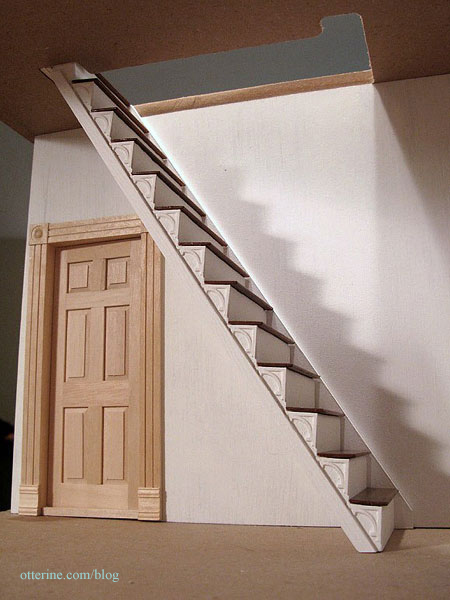
I spackled the back of the assembly and sanded it smooth.
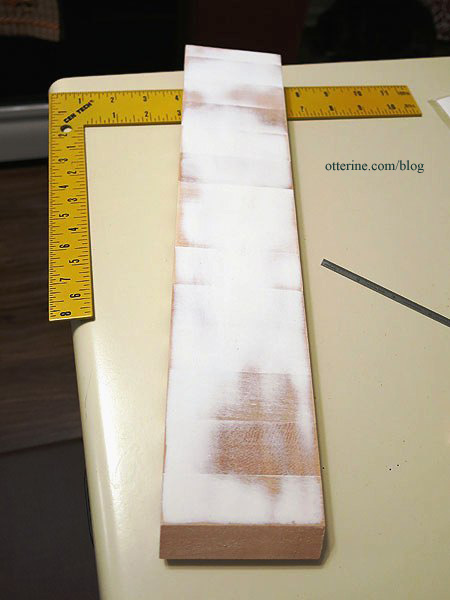
I added Laser Tech corners on 12 of the steps, just as I had done for the Newport.
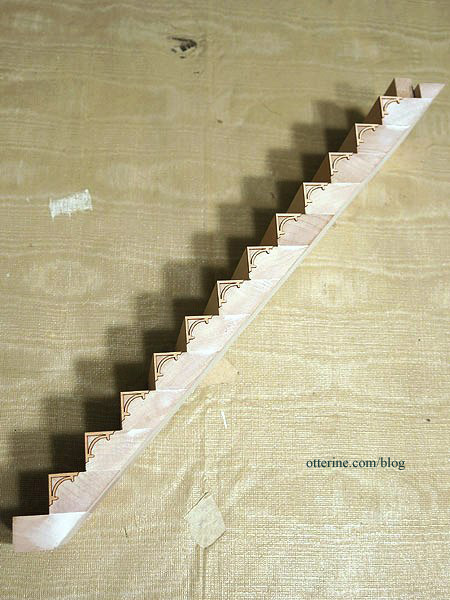
These are simple in design but add just enough interest.
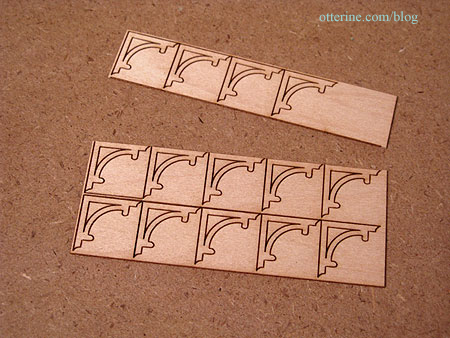
I painted the assembly white. Once dry, I’ll sand it smooth and put on a final coat of paint.
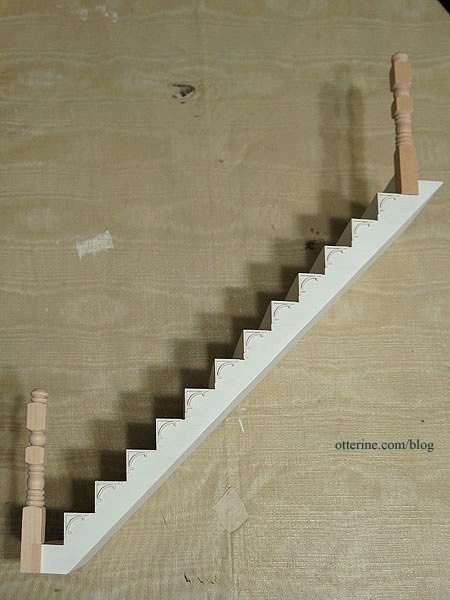
The newel posts really are spectacular in this kit. :]
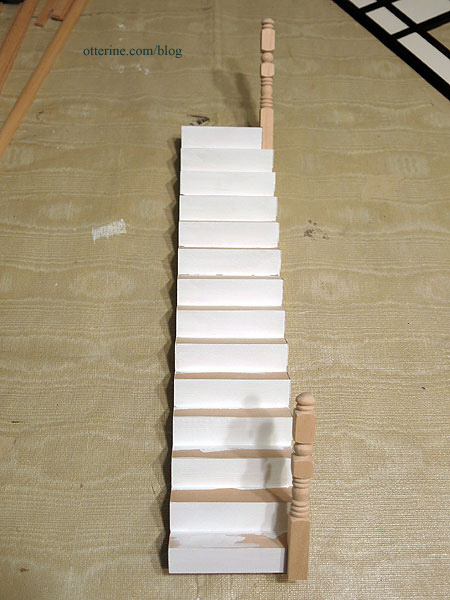
Next up, shaping the treads and staining the accent pieces.
Categories: The Brownstone
March 8, 2014 | 0 commentsThe Brownstone – trying out the final finishes
Today, I decided to proceed with the final finishes on the front wall of the side addition. I finished cutting the filler pieces and taped them to a painting board after numbering them on the back to help with reassembly.
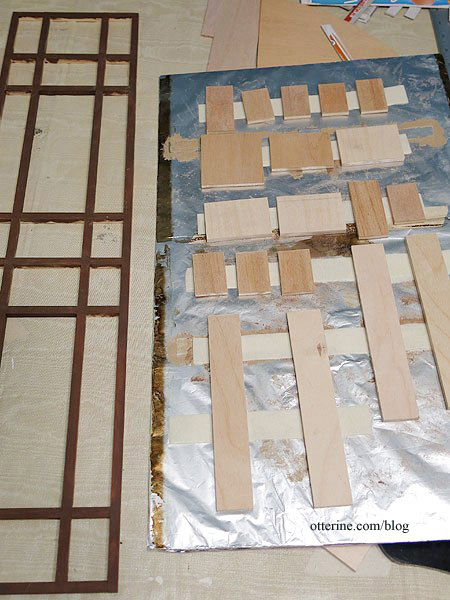
I painted the timber grid with a mix of Staining Medium and Bittersweet Chocolate by Americana. The previous base coat of Coffee Bean by Folk Art underneath created a subtle variegated color.
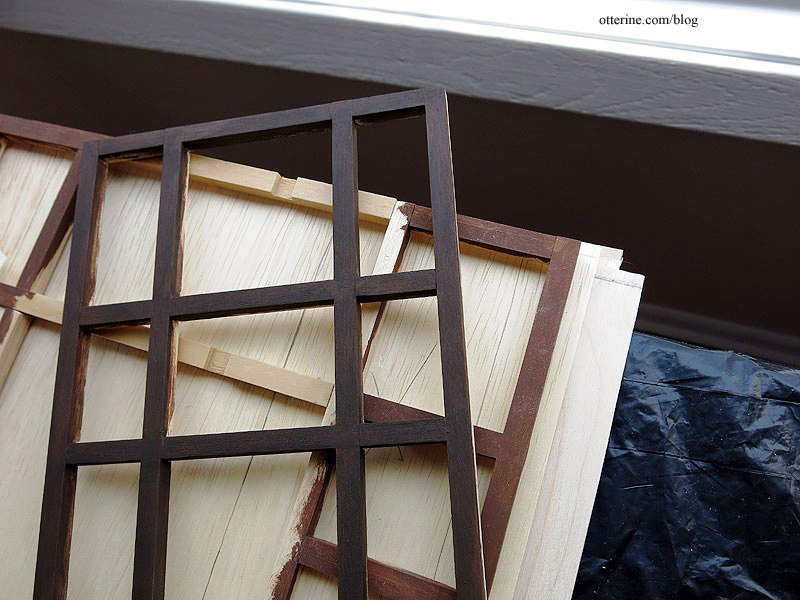
I finished the filler pieces in the same manner as the front door recess: one coat of matte gel medium and three coats of White Birch satin paint by Americana. I finished the timber grid with Delta Ceramcoat Satin Varnish. Once the pieces were dry, I pushed the filler pieces into the grid from the back. Most were so tight that no glue was needed. A few were looser.
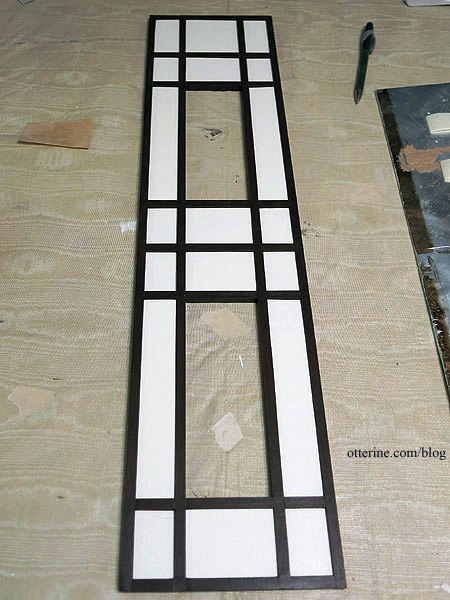
I flipped the assembly over and spread glue into the joins.
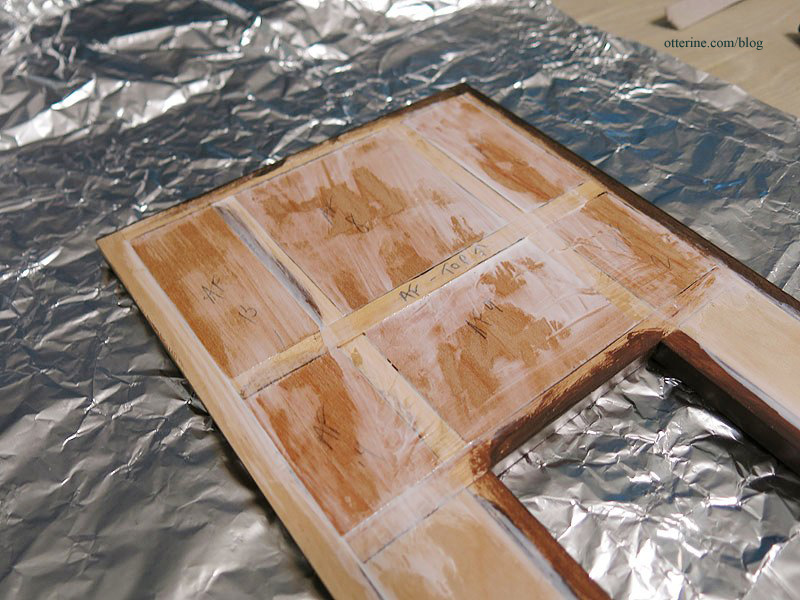
I love the colors and textures. :D
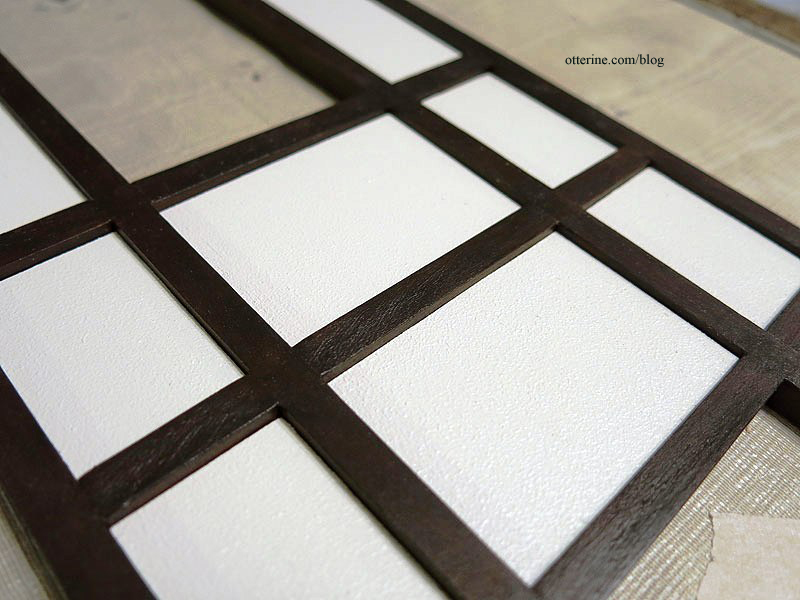
The surface assembly will stay separate until I get the windows built, but I placed it on the backer board to fit the top row of egg carton stones. The side pieces will be done later after the walls are joined, but it’s easier to do as much as possible while the boards can be placed flat on the work table.
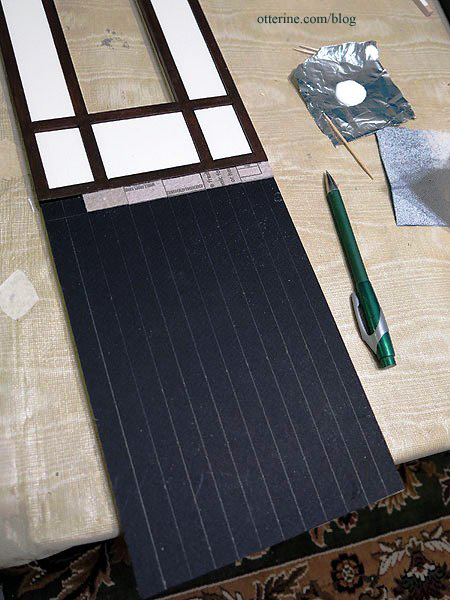
The base coat is Fawn by Americana. The stones will be deeper in color, like the front steps, but I will do the final washes all at once so that the color is consistent around the base of the entire building. So far, it’s turning out as I had hoped.
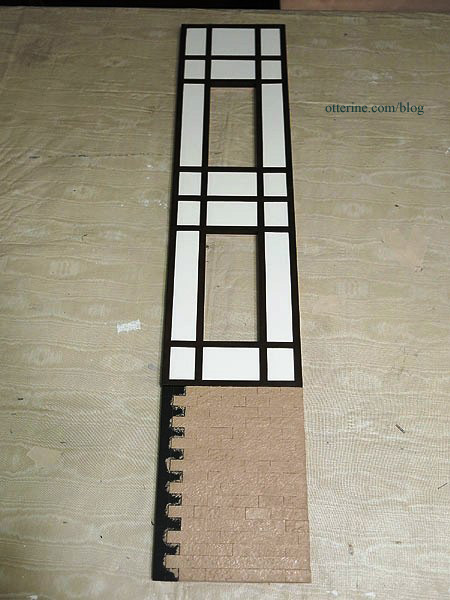
Categories: The Brownstone
March 2, 2014 | 0 commentsThe Brownstone – front door, part 4
Completed work on the front door. I cut two new sides from 1/4″ plywood to fit the kit top piece to form the recess. This mimics the kit construction with taller side boards.

I dabbed on matte gel medium using a foam brush onto the exterior surfaces of the recess after masking the gluing surfaces. I set these aside to dry.

Next up was addressing the interior trim. I used door and window casing that coordinates with the 5-panel doors I will use throughout. The trim will surround both the door and the transom window. I held it in place with mini hold wax for measuring purposes.

With the previously textured pieces now dry, I added three coats of White Birch satin paint by Americana. This will be one of the main exterior house colors. I again dabbed the paint on with a foam brush. This texture has the appearance of fine plaster without the added weight, thickness or mess of stucco.

The doorknobs are bronze, which I think works rather well with the color scheme. I painted a metal doorbell from my stash for the door frame.

I like to go that extra mile and drill holes for the lock mechanism. Just some dabs of black and bronze paint, and it gives the illusion of a lock plate at first glance.

With the paint dry on the recess pieces, I glued them to the door frame.

I used the new boards to mark the cut opening on the front backer board.

The height of my first floor ceiling will be 10 1/2″ so I cut another two side boards from 1/4″ plywood measuring 10 1/2″ long and glued them to the door frame. I also cut two boards to fill in the dead space above the front door recess.

Looks like a fine recessed door to me. :D
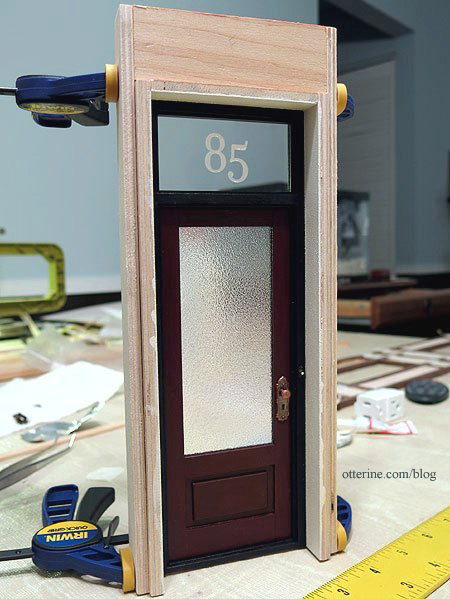
Categories: The Brownstone
February 25, 2014 | 0 comments
NOTE: All content on otterine.com is copyrighted and may not be reproduced in part or in whole. It takes a lot of time and effort to write and photograph for my blog. Please ask permission before reproducing any of my content. (More on copyright)



